Template category
Financial Agreements
Essential templates for invoices, receipts, order forms, client agreements, and more.
Financial Agreements
Table of Contents
1. Essential Financial Documents Overview
1.1 Promissory Note
1.2 Personal Loan Agreement
1.3 Payment Agreement
1.4 Loan Agreement
1.5 Personal Guarantee Agreement
1.6 Loan Modification Agreement
1.7 Security Agreement
1.8 Deed of Trust
1.9 Profit and Loss Statement
1.10 Donation Agreement
1.11 Credit Application Form
1.12 Debt Settlement Agreement
1.13 Power Purchase Agreement
1.14 ACH Authorization Form
1.15 SAFE Agreement (Simple Agreement for Future Equity)
1.16 Escrow Agreement
1.17 Intercreditor Agreement
1.18 Investor Rights Agreement
1.19 SAFT Agreement (Simple Agreement for Future Tokens)
1.20 Restricted Stock Agreement
1.21 Grant Agreement
1.22 Convertible Note Purchase Agreement
1.23 Debt Subordination Agreement
1.24 Installment Sale and Security Agreement
1.25 Balloon Note
1.26 Demand Note
1.27 Guaranty
1.28 Credit Information Request
1.29 Disputed Account Settlement
1.30 Advance Payment Agreement Template
1.31 Agreement to Pay Template
1.32 Billing Agreement Template
1.33 Credit Card Authorization Template
1.34 Debt Repayment Agreement Template
1.35 Demand Letter for Payment Template
1.36 Installment Payment Agreement Template
1.37 Late Payment Agreement Template
1.38 Loan Repayment Schedule Template
1.39 Partial Payment Agreement Template
1.40 Payment Arrangement Agreement Template
1.41 Payment Authorization Form Template
1.42 Payment Guarantee Agreement
1.43 Recurring Payment Agreement Template
1.44 Service Payment Agreement Template
1.45 Terms of Payment Template
2. Regional Requirements and Nuances
2.1 West Coast: California and Washington
2.2 Northeast: New York
2.3 Southern States: Texas and Florida
2.4 Midwest: Illinois
3. Legal & Industry Updates (2024–2025) Affecting Financial Agreements
3.1 Consumer Protection and Usury Laws
3.2 Data Privacy in Financial Contracts (2024–2025)
3.3 AI and Automation in Loan Processing (2024–2026)
4. Conclusion: Why Use AI Lawyer Templates for Financial Agreements
1. Essential Financial Documents Overview
Starting in the last few years, every financial transaction — from business loans to personal lending — has come to rely on well-structured financial agreements to ensure clarity, trust, and enforceability. These contracts are more than formalities; they’re the backbone of every monetary relationship, defining exactly who owes what, when, and under what conditions. Using standardized, AI-powered templates for financial agreements helps eliminate the guesswork and protect all parties from costly misunderstandings or disputes. By integrating proven legal frameworks and up-to-date compliance rules, these templates ensure your contracts are both clear and enforceable — reducing the risk of defaults, ambiguities, or litigation down the line.
Legal research consistently shows that poor documentation is one of the leading causes of financial disputes — with up to 40% of cases arising from unclear or incomplete terms. A well-drafted agreement, however, helps prevent those conflicts before they begin, clarifying repayment schedules, interest terms, collateral conditions, and remedies for default. The result? More predictable outcomes, stronger relationships, and fewer financial headaches. As courts across the U.S. increasingly emphasize written clarity and fair dealing, businesses that rely on structured agreements gain a major advantage in both credibility and protection.
AI-powered document tools like AI Lawyer make it effortless to generate precise, compliant financial agreements. These templates go beyond simple formatting — they embed state-specific usury laws, privacy safeguards, and enforcement provisions that automatically adapt to your jurisdiction. Whether you’re preparing a Loan Agreement, Promissory Note, Investment Contract, or Payment Plan, AI Lawyer ensures that every clause meets modern legal standards and aligns with your unique transaction goals.
This comprehensive guide explores the most essential types of financial agreements, their purposes, and key terms. You’ll also find a practical comparison table summarizing each agreement’s use case, legal focus, and drafting considerations. Finally, we’ll cover recent developments (2024–2025) affecting financial contracts — from new consumer lending laws to AI compliance in financial data handling — and show how AI-vetted templates can help you create clear, enforceable, and future-ready agreements with confidence.
Related Legal Resources
Quick Highlights:
Mitigating Risk Through Clear Terms: Proper financial agreements clearly specify repayment schedules, interest rates, default remedies, and collateral—minimizing the risk of disputes and defaults.
Efficiency via Standardization: Templates accelerate agreement preparation and maintain consistent quality, facilitating faster approvals and easier auditing.
Building Trust and Professionalism: Transparent, well-structured agreements foster confidence among parties and contribute to stronger business relationships.
AI-Driven Compliance Updates: AI-assisted templates keep your agreements current with changing laws and best practices, including state usury laws, data protection, and disclosure requirements.
1.1 Promissory Note

A Promissory Note is a simple yet legally binding financial instrument in which one party (the borrower) promises to repay a specific amount of money to another party (the lender) either on demand or by a set date. It clearly defines repayment obligations — including principal amount, interest rate, payment schedule, and maturity terms — ensuring both sides understand the financial commitment. Commonly used for personal loans, small business financing, or short-term lending between private parties, it provides written proof of debt without requiring collateral. A properly drafted note establishes accountability, prevents misunderstandings, and gives the lender enforceable rights if repayment is delayed or missed.
Using a standardized Promissory Note template ensures that all key terms — repayment structure, penalties for late payment, governing law, and signatures — are clearly documented. It also minimizes common drafting errors like missing maturity dates or unclear interest calculations that can make enforcement difficult. With AI-powered drafting tools such as AI Lawyer, the process becomes even simpler: the template automatically includes jurisdiction-specific language, interest rate limits, and legal clauses to comply with lending laws. By starting from a vetted, AI-enhanced template, both borrower and lender secure a clear, balanced, and enforceable agreement that protects their financial interests and reduces risk.
Download Template: Promissory Note
For more information please refer to our article: Promissory Note Template Guide (Free Download + AI Generator)
Or create your own document yourself with the help of AI.
1.2 Personal Loan Agreement

A Loan Agreement is a formal contract that defines the terms under which one party (the lender) provides funds to another (the borrower) with an obligation to repay, often including interest and a defined repayment schedule. It establishes the financial structure of the loan — outlining the principal amount, interest rate, repayment dates, and any collateral or guarantees involved. Unlike a simple Promissory Note, a Loan Agreement typically includes broader protections such as representations, covenants, and default clauses. It is widely used in both business and personal finance contexts where larger sums or longer repayment periods require greater clarity and security for all parties.
Using a standardized Loan Agreement template ensures every essential element is covered — from repayment schedules and late-fee provisions to governing law and dispute resolution mechanisms. It also helps avoid errors or omissions that can make a loan unenforceable or expose parties to unnecessary risks. AI-powered tools like AI Lawyer streamline this process by generating legally compliant templates that adapt to state-specific lending laws, interest rate limits, and collateral requirements. The result is a comprehensive, balanced agreement that protects both lender and borrower, speeds up deal execution, and provides a reliable framework for managing financial relationships.
Download Template: Personal Loan Agreement
Each state has its own rules and nuances — what’s valid in California might not hold in Texas or New York. Choose your jurisdiction-specific sample version for full compliance: California | New York | Texas | Florida | Illinois | Washington
For more information please refer to our article: Personal Loan Agreement Template - A Complete Guide (Free Download + AI Generator)
Or create your own document yourself with the help of AI.
1.3 Payment Agreement

A Payment Agreement is a formal contract that defines how an existing debt or overdue balance will be repaid over time. It establishes a clear repayment structure — including total amount owed, installment amounts, payment dates, interest or late fees, and consequences for default — converting an informal or disputed obligation into a legally enforceable plan. Commonly used in debt settlements, business payment plans, or restructuring agreements, it provides transparency and prevents misunderstandings by setting out when and how payments must be made. This document is especially useful for resolving financial disputes without litigation, as it formalizes repayment terms and helps both parties avoid future conflict.
Using a standardized Payment Agreement template ensures that all essential elements are covered — such as the description of the original debt, payment schedule, default clauses, and governing law. It also clarifies whether payments apply to principal, interest, or fees, protecting creditors from uncertainty and debtors from unfair terms. AI-powered drafting tools like AI Lawyer simplify this process by automatically including legally required provisions, calculating payment schedules, and adapting the document to state-specific laws. By starting from a vetted template, both parties gain a clear, balanced, and enforceable repayment plan that promotes accountability, compliance, and smoother financial resolution.
Download Template: Payment Agreement
Each state has its own rules and nuances — what’s valid in California might not hold in Texas or New York. Choose your jurisdiction-specific sample version for full compliance: California | New York | Texas | Florida | Illinois | Washington
For more information please refer to our article: Payment Agreement Template Guide (Free Download + AI Generator)
Or create your own document yourself with the help of AI.
1.4 Loan Agreement

A Loan Agreement is a comprehensive financial contract that defines the terms under which a lender provides funds to a borrower, detailing the loan amount, interest rate, repayment schedule, collateral, and remedies in case of default. It serves as the primary legal framework for business loans, real estate financing, or substantial personal loans where large sums and complex conditions require full documentation. This agreement protects the lender’s interests while ensuring the borrower understands their obligations — covering key provisions such as security rights, borrower representations, and default triggers. It is enforceable in court and, when collateral is pledged, may also be registered with relevant authorities to perfect the lender’s security interest.
Using a standardized Loan Agreement template ensures that all critical terms — including repayment timelines, interest calculations, collateral descriptions, and default procedures — are precisely stated. It helps prevent costly mistakes like missing warranties, unclear remedies, or unperfected liens that could weaken enforceability. AI-powered drafting tools like AI Lawyer streamline the process by incorporating jurisdiction-specific lending rules, standard covenants, and automated compliance checks. By starting with a vetted template, both lender and borrower gain a clear, balanced, and legally sound agreement that promotes transparency, minimizes risk, and provides a dependable framework for managing financial obligations.
Download Template: Loan Agreement
For more information please refer to our article: Loan Agreement Template- A complete Guide (Free Download + AI Generator)
Or create your own document yourself with the help of AI.
1.5 Personal Guarantee Agreement

A Personal Guarantee Agreement is a legal document in which an individual (the guarantor) agrees to be personally responsible for another party’s financial obligation, typically a business loan or lease. It ensures the lender can recover the debt even if the primary borrower defaults, adding an extra layer of security to the transaction. Commonly used in business financing, commercial leases, and supplier credit arrangements, this agreement reassures creditors by tying repayment to the guarantor’s personal assets or income.
Using a standardized Personal Guarantee Agreement template helps clearly define the guarantor’s liability, scope of guarantee (limited or unlimited), and conditions under which it applies. It also includes essential clauses such as waiver of defenses, notice of default, and governing law. AI-powered templates can adapt to jurisdiction-specific rules — for example, disclosure requirements in states like California or New York that mandate clear acknowledgment of personal liability. By starting from a vetted template, lenders and guarantors gain clarity, enforceability, and confidence that all legal safeguards are properly addressed.
Download Template: Personal Guarantee Agreement
For more information please refer to our article:
Or create your own document yourself with the help of AI.
1.6 Loan Modification Agreement

A Loan Modification Agreement is a formal contract that revises the original terms of an existing loan without creating a new one. It’s commonly used when borrowers experience financial hardship or when both parties wish to adjust repayment conditions — such as extending the term, lowering the interest rate, or changing the payment schedule — to avoid default. This agreement ensures that any modifications are legally binding and clearly documented, protecting both lender and borrower from future misunderstandings.
Using a standardized Loan Modification Agreement template helps outline the modified terms in precise language, referencing the original loan while specifying exactly what has changed. It also includes key provisions such as reaffirmation of the remaining debt, representations by the borrower, default clauses, and governing law. AI-powered templates simplify customization, ensuring compliance with lending regulations and consumer protection laws that vary by state. By starting from a vetted template, both parties can securely amend existing obligations while preserving enforceability and maintaining clear records of every adjustment.
Download Template: Loan Modification Agreement
For more information please refer to our article:
Or create your own document yourself with the help of AI.
1.7 Security Agreement

A Security Agreement is a contract that grants a lender (secured party) a legal interest in a borrower’s personal property (collateral) as security for a loan or other obligation. It defines what assets secure the debt — such as equipment, inventory, vehicles, or receivables — and gives the lender the right to seize or sell that collateral if the borrower defaults. This agreement is essential in secured lending, ensuring the lender’s priority claim over the pledged assets under the Uniform Commercial Code (UCC).
Using a standardized Security Agreement template ensures all crucial elements are included: identification of the parties, detailed description of collateral, obligations secured, perfection and filing provisions (like UCC-1 filings), rights upon default, and governing law. The template also helps avoid errors that could invalidate the security interest — for instance, vague collateral descriptions or missing signatures. AI-powered drafting tools automatically adapt clauses to local UCC requirements and generate reminders for filing deadlines. By starting from a vetted template, lenders can properly secure their interests, and borrowers can ensure transparency and compliance in the loan’s collateralization process.
Download Template: Security Agreement
For more information please refer to our article:
Or create your own document yourself with the help of AI.
1.8 Deed of Trust

A Deed of Trust is a legal document used in real estate financing that secures a loan with property. It involves three parties: the borrower (trustor), the lender (beneficiary), and a neutral third party (trustee) who holds the property title until the loan is repaid. Unlike a mortgage, which involves only two parties, a Deed of Trust allows the trustee to sell the property through a nonjudicial foreclosure if the borrower defaults — a faster and less costly process for lenders. Commonly used in states like California, Texas, and Virginia, this document provides an efficient mechanism for securing real property loans.
Using a standardized Deed of Trust template ensures all critical provisions are included: property description, loan amount, repayment terms, trustee’s powers, borrower covenants, insurance and tax obligations, and procedures for default and foreclosure. The template also helps ensure compliance with state-specific foreclosure laws and disclosure requirements. AI-powered drafting tools automatically adjust clauses for jurisdictional nuances — for example, specifying nonjudicial foreclosure procedures where permitted. By starting from a vetted template, lenders and borrowers gain a transparent, enforceable framework that protects property rights while streamlining loan security and repayment enforcement.
Download Template: Deed of Trust
For more information please refer to our article:
Or create your own document yourself with the help of AI.
1.9 Profit and Loss Statement

A Profit and Loss Statement (P&L), also known as an Income Statement, is a financial document that summarizes a company’s revenues, costs, and expenses over a specific period—typically monthly, quarterly, or annually. It shows how effectively a business is generating profit by comparing total income against operational and non-operational expenses. This statement is essential for evaluating financial performance, identifying trends, and guiding strategic decisions for growth or cost management.
Using a standardized Profit and Loss Statement template ensures that all critical financial data is captured consistently: revenue streams, cost of goods sold (COGS), gross profit, operating expenses, net income, and tax obligations. It provides a clear structure for both internal reporting and external use—such as investor presentations, loan applications, or audits. AI-powered tools like AI Lawyer can help generate or analyze P&L statements automatically, flagging inconsistencies and aligning the document with accepted accounting standards (GAAP or IFRS). By starting from a vetted template, businesses can maintain transparency, streamline financial reporting, and make data-driven decisions with confidence.
Download Template: Profit and Loss Statement
For more information please refer to our article:
Or create your own document yourself with the help of AI.
1.10 Donation Agreement

A Donation Agreement is a legal document that records the terms under which a donor gives money, property, or other assets to a recipient — such as a nonprofit organization, educational institution, or individual — without expecting repayment. It specifies the purpose of the donation, any conditions attached, and how the funds or assets should be used. This agreement helps ensure transparency, accountability, and mutual understanding, protecting both donor intent and recipient responsibilities.
Using a standardized Donation Agreement template ensures all key elements are covered: donor and recipient details, description and value of the donation, intended purpose or restrictions, acknowledgment clauses, tax-related representations, and provisions for return or redirection if conditions aren’t met. It also helps document compliance with charitable contribution laws and IRS requirements for tax-deductible gifts. AI-powered templates can automatically adjust language for one-time or recurring donations, corporate sponsorships, or restricted gifts. By starting from a vetted template, both donors and recipients establish a clear, legally sound record of the transaction — fostering trust, legal compliance, and ethical stewardship of charitable contributions.
Download Template: Donation Agreement
For more information please refer to our article:
Or create your own document yourself with the help of AI.
1.11 Credit Application Form

A Credit Application Form is a standardized document used by lenders, suppliers, or service providers to evaluate an applicant’s creditworthiness before extending loans, credit lines, or payment terms. It collects essential financial and personal information — such as income, assets, debts, and references — to assess the applicant’s ability and willingness to repay. This form is a crucial first step in risk management and helps organizations make informed, compliant lending or business credit decisions.
Using a standardized Credit Application Form template ensures consistency and completeness across all applications. It typically includes applicant identification, business or employment details, financial history, references, consent for credit checks, and terms for data usage and verification. A well-drafted form also includes clear disclosures and applicant authorizations to comply with consumer protection and privacy laws (like the Fair Credit Reporting Act in the U.S.). AI-powered templates simplify customization for different industries — from banking to trade credit — and can automatically integrate consent language, scoring criteria, and data privacy compliance. By starting from a vetted template, businesses streamline onboarding, reduce legal exposure, and maintain transparent and fair credit evaluation practices.
Download Template: Credit Application Form
For more information please refer to our article:
Or create your own document yourself with the help of AI.
1.12 Debt Settlement Agreement

A Debt Settlement Agreement is a legally binding document between a debtor and a creditor that outlines the terms under which an outstanding debt will be partially repaid, forgiven, or restructured. It specifies the reduced settlement amount, payment deadlines, and the creditor’s agreement to consider the debt satisfied once payment is made. This agreement helps both parties avoid litigation, collections, or bankruptcy by reaching a mutually acceptable resolution.
Using a standardized Debt Settlement Agreement template ensures all essential terms are addressed: total debt owed, negotiated settlement amount, payment schedule, release of further claims, confidentiality, and governing law. It also includes clauses protecting both sides—such as requiring written confirmation of settlement and specifying that the creditor won’t pursue the remaining balance once the agreed amount is paid. AI-powered templates from AI Lawyer can adapt the agreement for different jurisdictions and include relevant consumer protection language, ensuring fairness and enforceability. By starting from a vetted template, both creditors and debtors can finalize settlements confidently, reduce risk, and formalize financial closure with clear legal certainty.
Download Template: Debt Settlement Agreement
For more information please refer to our article:
Or create your own document yourself with the help of AI.
1.13 Power Purchase Agreement

A Power Purchase Agreement (PPA) is a long-term contract between an electricity generator (such as a renewable energy producer) and a buyer (often a utility company, corporation, or government entity) that defines the terms of energy sale and purchase. It specifies how much power will be supplied, at what price, and over what duration. PPAs are essential for financing and operating energy projects — they guarantee revenue for producers and ensure stable pricing for buyers.
Using a standardized Power Purchase Agreement template ensures all key terms are clearly defined: project description, delivery and metering arrangements, pricing structure (fixed, variable, or indexed), duration, performance guarantees, force majeure, and termination rights. It also covers compliance with environmental and regulatory requirements, grid interconnection obligations, and dispute resolution mechanisms. AI-powered templates can tailor clauses for renewable energy (like solar or wind) and regional regulations, automatically updating pricing and compliance provisions. By starting from a vetted PPA template, both energy producers and buyers secure a balanced, transparent, and legally enforceable foundation that supports investment confidence and long-term operational stability.
Download Template: Power Purchase Agreement
For more information please refer to our article:
Or create your own document yourself with the help of AI.
1.14 ACH Authorization Form

An ACH Authorization Form is a document that gives a business or financial institution permission to withdraw or deposit funds directly from a customer’s or client’s bank account via the Automated Clearing House (ACH) network. It is commonly used for recurring payments, payroll deposits, loan repayments, and subscription billing. The form serves as both legal consent and proof of authorization, ensuring compliance with banking regulations and protecting against unauthorized transactions.
Using a standardized ACH Authorization Form template ensures all required information is properly captured — including account holder details, bank routing and account numbers, transaction type (debit or credit), frequency, amount, and cancellation rights. It also includes mandatory legal language required under the NACHA Operating Rules and Regulation E, confirming the customer’s informed consent for electronic fund transfers. AI-powered templates make it easy to generate secure, compliant forms with e-signature capabilities and audit-ready consent tracking. By starting from a vetted template, businesses can streamline payment collection, reduce errors, maintain compliance, and provide customers with a transparent, legally valid authorization process.
Download Template: ACH Authorization Form
For more information please refer to our article:
Or create your own document yourself with the help of AI.
1.15 SAFE Agreement

A SAFE Agreement (Simple Agreement for Future Equity) is a modern investment contract used primarily by startups to raise early-stage capital. It allows investors to provide funding in exchange for the right to receive equity in the company at a later date — typically when a priced funding round or liquidity event occurs. Unlike traditional convertible notes, SAFEs do not accrue interest or have a maturity date, making them simpler and more flexible for both founders and investors.
Using a standardized SAFE Agreement template ensures that key elements are properly defined: investment amount, valuation cap, discount rate (if applicable), conversion trigger events, and investor rights. It also includes clauses covering representations, transfer restrictions, and governing law. AI-powered SAFE templates automatically adapt to different funding structures (such as post-money or pre-money SAFEs) and integrate up-to-date investor disclosure requirements. By starting from a vetted SAFE Agreement template, startups can secure early investment quickly and transparently, while investors gain confidence that their future equity rights are clearly established and legally protected.
Download Template: SAFE Agreement
For more information please refer to our article:
Or create your own document yourself with the help of AI.
1.16 Escrow Agreement

An Escrow Agreement is a legal contract that establishes a neutral third party (the escrow agent) to hold funds, assets, or documents on behalf of transacting parties until specified conditions are met. Commonly used in real estate, mergers and acquisitions, software licensing, and large commercial transactions, it ensures that both buyer and seller fulfill their obligations before any money or property changes hands.
Using a standardized Escrow Agreement template helps define all key components: the roles and responsibilities of the escrow agent, deposit and release conditions, dispute resolution procedures, and fees. It also clarifies the rights of each party in the event of default, cancellation, or breach. AI-powered templates ensure compliance with applicable financial and regulatory laws (such as anti-money laundering rules) and allow for customized escrow instructions for different industries — from software source code escrow to real estate deposits. By starting from a vetted Escrow Agreement template, all parties gain transparency, trust, and legal protection, minimizing risks and ensuring secure, orderly completion of high-value transactions.
Download Template: Escrow Agreement
For more information please refer to our article:
Or create your own document yourself with the help of AI.
1.17 Intercreditor Agreement

An Intercreditor Agreement is a contract between two or more lenders that defines their respective rights, priorities, and obligations concerning a shared borrower. It is commonly used in complex financing structures where multiple creditors — such as senior and subordinated lenders — have claims to the same collateral or borrower assets. The agreement ensures clarity on payment order, enforcement rights, and how proceeds are distributed in case of default or insolvency.
Using a standardized Intercreditor Agreement template ensures that critical provisions are covered, including payment priority (“waterfall” structure), lien subordination, standstill obligations, information sharing, voting rights on amendments, and remedies upon borrower default. It also defines how collateral is handled and who leads enforcement actions. AI-powered templates adapt these terms to jurisdiction-specific lending laws and industry standards, automatically inserting compliant clauses for secured transactions. By starting from a vetted Intercreditor Agreement template, lenders can avoid costly disputes, align expectations, and create a transparent framework that balances creditor protection with borrower flexibility.
Download Template: Intercreditor Agreement
For more information please refer to our article:
Or create your own document yourself with the help of AI.
1.18 Investor Rights Agreement

An Investor Rights Agreement (IRA) is a key document used in venture capital and private equity deals to define the rights and protections of investors after they acquire shares in a company. It outlines governance, information, and financial rights that ensure investors have transparency and influence over significant business decisions. Commonly signed alongside a Stock Purchase or SAFE Agreement, it helps align investor and company interests while protecting minority shareholders.
Using a standardized Investor Rights Agreement template ensures inclusion of all critical provisions: information rights (regular financial reporting), registration rights (for future public offerings), preemptive rights (to maintain ownership percentage), and protective provisions (requiring investor consent for major company actions). It also defines confidentiality duties, dispute resolution mechanisms, and governing law. AI-powered IRA templates automatically adapt to funding stage and jurisdiction, inserting compliant language for securities laws and investor disclosure obligations. By starting with a vetted Investor Rights Agreement template, startups and investors establish a clear, fair, and enforceable framework that fosters trust, transparency, and long-term collaboration.
Download Template: Investor Rights Agreement
For more information please refer to our article:
Or create your own document yourself with the help of AI.
1.19 SAFT Agreement

A Simple Agreement for Future Tokens (SAFT) is a legal contract used in blockchain and cryptocurrency projects to raise capital before launching a token or network. It allows investors to provide funding in exchange for the right to receive digital tokens at a later date, typically once the project is functional and compliant with securities regulations. The SAFT model was developed to bring legal clarity to token pre-sales and reduce regulatory risks compared to informal ICOs.
Using a standardized SAFT Agreement template ensures inclusion of all essential terms: purchase amount, delivery conditions for tokens, representations and warranties, investor eligibility, compliance with securities laws, and disclaimers regarding token utility and risk. It also outlines what happens if the project fails to launch or regulatory changes occur. AI-powered SAFT templates help align with the latest SEC guidance, FinCEN rules, and global crypto compliance standards, ensuring your token offering remains legally defensible. By starting from a vetted SAFT Agreement template, blockchain founders and investors can secure funding transparently while maintaining compliance and investor confidence.
Download Template: SAFT Agreement
For more information please refer to our article:
Or create your own document yourself with the help of AI.
1.20 Restricted Stock Agreement

A Restricted Stock Agreement is a contract between a company and an employee, founder, or investor outlining the terms under which shares are issued but subject to vesting or transfer restrictions. It’s commonly used in startups and private companies to align incentives — granting ownership that vests over time or upon meeting performance milestones. This agreement helps ensure commitment and protect the company if the recipient leaves before full vesting.
Using a standardized Restricted Stock Agreement template ensures all key elements are clearly defined: number of shares granted, purchase price (if any), vesting schedule, repurchase rights, tax election options (such as the IRS 83(b) election), and conditions under which shares may be forfeited. It also includes confidentiality and non-compete clauses where applicable. AI-powered templates automatically adapt to federal and state securities laws, incorporating proper legends and notices for restricted stock issuances. By starting with a vetted Restricted Stock Agreement template, companies can safeguard equity distribution, maintain compliance, and foster long-term alignment between stakeholders and the business.
Download Template: Restricted Stock Agreement
For more information please refer to our article:
Or create your own document yourself with the help of AI.
1.21 Grant Agreement

A Grant Agreement is a formal contract used when an organization, government body, or foundation provides funds to another party (such as a nonprofit, researcher, or business) for a specific project or purpose. Unlike a loan or investment, a grant does not require repayment but carries strict conditions on how the funds must be used. The agreement outlines responsibilities, reporting obligations, and consequences for misuse of funds, ensuring accountability and compliance.
Using a standardized Grant Agreement template ensures all essential elements are included: grant amount, purpose and scope of use, milestones or deliverables, reporting and audit requirements, payment schedule, termination rights, and governing law. It also defines intellectual property ownership for any resulting work and confidentiality obligations. AI-powered templates help tailor terms for government, research, or private foundation grants — automatically inserting compliance clauses such as anti-corruption, data protection, and record-keeping requirements. By starting from a vetted Grant Agreement template, both grantors and recipients can establish transparency, ensure legal compliance, and maintain trust throughout the funding relationship.
Download Template: Grant Agreement
For more information please refer to our article:
Or create your own document yourself with the help of AI.
1.22 Convertible Note Purchase Agreement

A Convertible Note Purchase Agreement is a contract between an investor and a company that outlines the terms of a short-term debt investment that can later convert into equity. Commonly used in startup financing, this agreement allows investors to provide immediate funding while deferring valuation discussions until a future equity round. The note typically converts into preferred shares at a discount or with a valuation cap once new investors enter.
Using a standardized Convertible Note Purchase Agreement template ensures all critical terms are properly defined: purchase amount, interest rate, maturity date, conversion trigger events, valuation cap, discount rate, and repayment conditions. It also includes representations and warranties, investor rights, and governing law provisions. AI-powered templates from AI Lawyer automatically integrate current startup financing standards, including SAFE conversion compatibility and applicable securities law disclosures. By using a vetted Convertible Note Purchase Agreement, founders and investors can streamline early-stage fundraising, minimize negotiation friction, and ensure legally compliant conversion to equity when the company raises its next round.
Download Template: Convertible Note Purchase Agreement
For more information please refer to our article:
Or create your own document yourself with the help of AI.
1.23 Debt Subordination Agreement

A Debt Subordination Agreement is a contract that establishes the priority of debt repayment among multiple creditors of the same borrower. It specifies that one creditor’s claim (the subordinated debt) will be paid only after another creditor’s claim (the senior debt) has been satisfied. This agreement is commonly used in complex financing structures, such as when a company has both bank loans and shareholder loans, ensuring clear hierarchy and reducing conflicts during repayment or bankruptcy.
Using a standardized Debt Subordination Agreement template ensures all essential elements are included: identification of senior and subordinated debts, repayment restrictions, payment blockage clauses, waiver of rights to collateral, and conditions for subordination termination. It also defines enforcement procedures and governing law. AI-powered templates automatically align with lending regulations and industry norms, adapting language for secured or unsecured debt arrangements. By starting from a vetted template, lenders and borrowers can clearly document repayment priority, protect senior creditor interests, and maintain smoother coordination between multiple financing parties.
Download Template: Debt Subordination Agreement
For more information please refer to our article:
Or create your own document yourself with the help of AI.
1.24 Installment Sale and Security Agreement

An Installment Sale and Security Agreement is a contract used when goods or property are sold with payment made over time rather than upfront. It allows the seller to retain a security interest in the goods until the buyer completes all payments, protecting the seller’s ownership rights in case of default. This type of agreement is common in equipment sales, vehicle financing, or business asset transfers where the buyer takes possession immediately but full ownership transfers only after final payment.
Using a standardized Installment Sale and Security Agreement template ensures all key provisions are clearly defined: purchase price, payment schedule, interest rate, late fees, description of collateral, default remedies, and repossession rights. It also includes clauses on warranties, insurance, taxes, and governing law. AI-powered templates automatically insert jurisdiction-specific Uniform Commercial Code (UCC) provisions and filing requirements to perfect the seller’s security interest. By starting from a vetted template, both parties ensure legal compliance, transparent payment terms, and strong protection of financial and property rights throughout the installment period.
Download Template: Installment Sale and Security Agreement
For more information please refer to our article:
Or create your own document yourself with the help of AI.
1.25 Balloon Note

A Balloon Note is a type of promissory note where the borrower makes smaller periodic payments over time, followed by a large final “balloon” payment covering the remaining balance at maturity. This structure is common in real estate, equipment financing, and commercial loans, allowing borrowers to manage early cash flow while planning for refinancing or increased income later. It provides short-term affordability with a clear long-term obligation.
Using a standardized Balloon Note template ensures that all critical terms — including interest rate, installment schedule, balloon payment amount, and maturity date — are clearly defined. AI-powered templates from AI Lawyer automatically calculate interest and final payment amounts, include proper default and acceleration clauses, and ensure compliance with state usury and disclosure laws. With a vetted template, lenders gain secure repayment structures, and borrowers benefit from clear, flexible terms that support their financial planning.
Download Template: Balloon Note
For more information please refer to our article:
Or create your own document yourself with the help of AI.
1.26 Demand Note

A Demand Note is a short-term financial instrument that allows the lender to require repayment of the loan at any time (“on demand”), without a fixed repayment schedule. It’s commonly used for flexible lending arrangements between businesses, shareholders, or individuals where repayment depends on mutual agreement or cash flow conditions. This type of note provides liquidity flexibility for the borrower while giving the lender the right to recover funds whenever needed.
Using a standardized Demand Note template ensures all key details — such as principal amount, interest rate, repayment process, and notice requirements — are clearly defined and legally sound. AI-powered templates from AI Lawyer incorporate state-specific rules on interest and demand procedures, making the document enforceable and compliant. By starting with a vetted template, both lenders and borrowers benefit from transparency, clear obligations, and protection against potential disputes.
Download Template: Demand Note
For more information please refer to our article:
Or create your own document yourself with the help of AI.
1.27 Guaranty

A Guaranty is a legal agreement in which one party (the guarantor) promises to take responsibility for another party’s debt or obligation if that party fails to meet it. This type of document is widely used in business loans, leases, and credit transactions to give lenders or creditors additional security. By guaranteeing repayment or performance, the guarantor helps reduce lender risk and often enables the borrower to secure better loan terms or credit approval.
Using a standardized Guaranty template ensures that all essential terms are properly defined — including the scope of liability, triggering conditions, waiver of defenses, and governing law. AI-powered templates from AI Lawyer adapt the document for personal, corporate, or limited guaranties, ensuring compliance with local legal standards and enforceability. With a vetted Guaranty template, both lenders and guarantors gain clarity and confidence: lenders know their backup protection is solid, while guarantors understand the extent of their commitment.
Download Template: Guaranty
For more information please refer to our article:
Or create your own document yourself with the help of AI.
1.28 Credit Information Request

A Credit Information Request is a formal document used to obtain an individual’s or business’s credit details from a financial institution, client, or credit bureau. It’s commonly used by lenders, suppliers, and landlords to assess creditworthiness before extending loans, credit lines, or lease agreements. The request typically seeks information such as payment history, outstanding debts, and overall credit behavior, helping the requesting party evaluate financial reliability and risk.
Using a standardized Credit Information Request template ensures consistency and compliance with privacy and data protection laws like the Fair Credit Reporting Act (FCRA) or GDPR for international use. AI-powered templates from AI Lawyer help include proper authorization language, disclosure clauses, and consent requirements. By starting with a vetted template, businesses can efficiently obtain necessary credit data while maintaining transparency and protecting sensitive financial information.
Download Template: Credit Information Request
For more information please refer to our article:
Or create your own document yourself with the help of AI.
1.29 Disputed Account Settlement

A Disputed Account Settlement is an agreement used to resolve disagreements over outstanding debts or billing discrepancies between parties. It outlines the disputed amount, terms of resolution, and any payments or adjustments made to close the matter. This type of agreement is often used between businesses, lenders, or service providers and clients to prevent litigation and preserve business relationships through negotiated compromise.
Using a standardized Disputed Account Settlement template ensures that key details — such as the amount in dispute, settlement terms, release of claims, and governing law — are clearly defined and enforceable. AI-powered templates from AI Lawyer help include proper legal language for mutual release and non-admission of liability while ensuring compliance with consumer protection and debt collection laws. By starting with a vetted template, both parties can reach a fair, binding resolution and avoid future misunderstandings or renewed claims.
Download Template: Disputed Account Settlement
For more information please refer to our article:
Or create your own document yourself with the help of AI.
1.30 Advance Payment Agreement Template
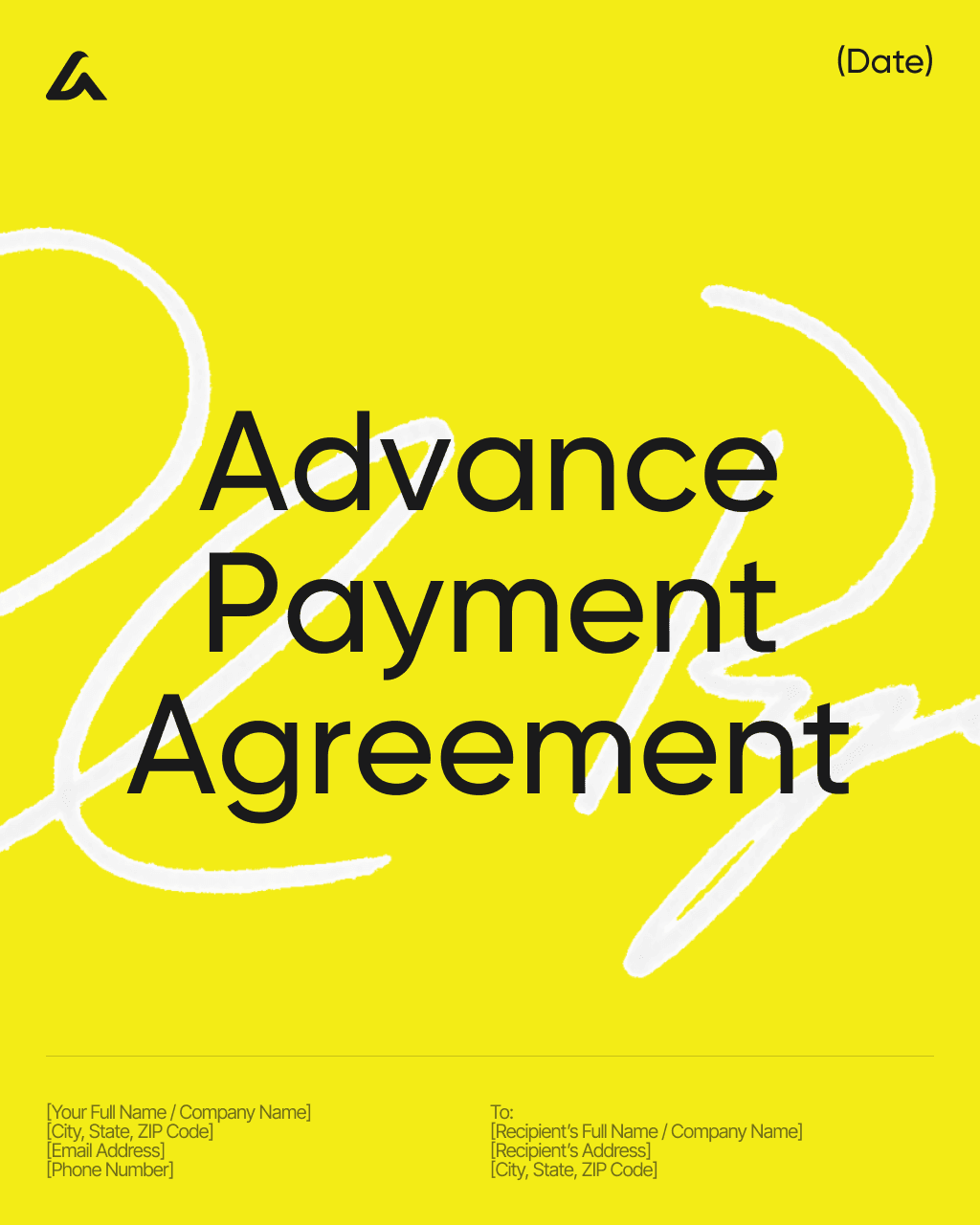
An Advance Payment Agreement is a formal contract used when a client or customer pays a portion—or the full amount—of a service or product cost before the work is performed or goods are delivered. Its purpose is to clearly outline the amount of the advance payment, what it covers, when the remaining balance (if any) is due, and the obligations of both parties. This agreement helps protect businesses from financial risk, ensures mutual expectations are understood, and provides legal assurance that the client is committed to the project or purchase.
Using a standardized Advance Payment Agreement template ensures that all essential terms are included—such as the advance payment amount, due date, refund or non-refund provisions, delivery timelines, responsibilities of each party, acceptable payment methods, and consequences of cancellation or nonpayment. The template may also include clauses for dispute resolution, late fees, termination rights, and applicable governing law. AI-powered tools like AI Lawyer help businesses generate clear, customized agreements that reduce misunderstandings, protect revenue, and maintain professional documentation. The result is a well-structured, enforceable agreement that safeguards both financial interests and the workflow of the business.
Download Template: Advance Payment Agreement Template
For more information please refer to our article: Payment Agreement Templates: U.S. Payment Terms for Any Scenario
Or create your own document yourself with the help of AI.
1.31 Agreement to Pay Template

An Agreement to Pay is a formal document outlining a borrower’s or customer’s promise to repay a specific amount of money under agreed-upon terms. It is commonly used in situations involving repayment of debts, outstanding balances, installment arrangements, or settlements. Its purpose is to clearly define the payment amount, schedule, interest (if applicable), consequences for late or missed payments, and the rights and obligations of both parties. This agreement helps ensure accountability, reduces the risk of disputes, and provides legally enforceable proof of the repayment arrangement.
Using a standardized Agreement to Pay template ensures that all essential components are included—such as the total amount owed, payment deadlines, installment breakdowns, acceptable payment methods, interest or fees, default terms, and remedies available in case of nonpayment. The template may also incorporate clauses related to collateral, acceleration of debt upon breach, dispute resolution, and governing law. AI-powered tools like AI Lawyer help users create precise, professional, and legally sound agreements that protect financial interests and support smooth repayment processes. The result is a clear, enforceable document that minimizes misunderstandings and provides confidence for both parties in the repayment arrangement.
Download Template: Agreement to Pay Template
For more information please refer to our article: Payment Agreement Templates: U.S. Payment Terms for Any Scenario
Or create your own document yourself with the help of AI.
1.32 Billing Agreement Template
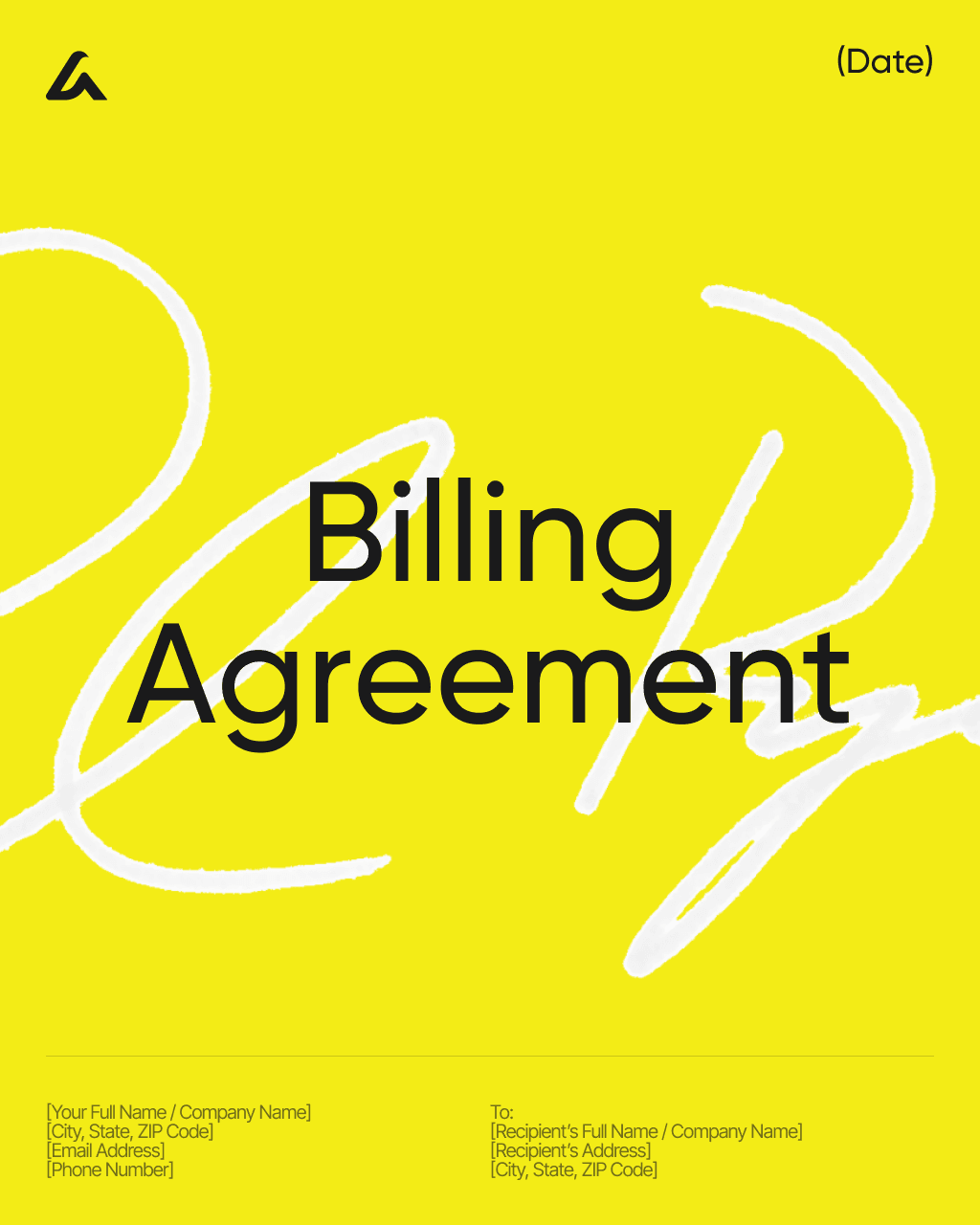
A Billing Agreement is a formal document that outlines how payments will be billed, processed, and collected for ongoing services, subscriptions, or recurring transactions between a business and a customer. Its purpose is to establish clear financial expectations—such as billing frequency, payment methods, invoicing procedures, and responsibilities—so both parties understand exactly how and when charges will occur. This agreement is commonly used by service providers, contractors, software companies, healthcare providers, and any business offering repeat or long-term services.
Using a standardized Billing Agreement template ensures that all key elements are included—such as billing cycles (weekly, monthly, quarterly), automatic payment authorization, rates or fees, late payment penalties, refund or cancellation policies, and any changes to pricing over time. The template may also address data security for stored payment information, communication procedures for invoice disputes, and termination conditions. AI-powered tools like AI Lawyer help businesses generate clear, compliant billing agreements tailored to their services and industry requirements, reducing the risk of misunderstandings, chargebacks, or payment delays. The result is a professional, well-structured agreement that protects cash flow, ensures accountability, and supports smooth ongoing billing relationships.
Download Template: Billing Agreement Template
For more information please refer to our article: Payment Agreement Templates: U.S. Payment Terms for Any Scenario
Or create your own document yourself with the help of AI.
1.33 Credit Card Authorization Template
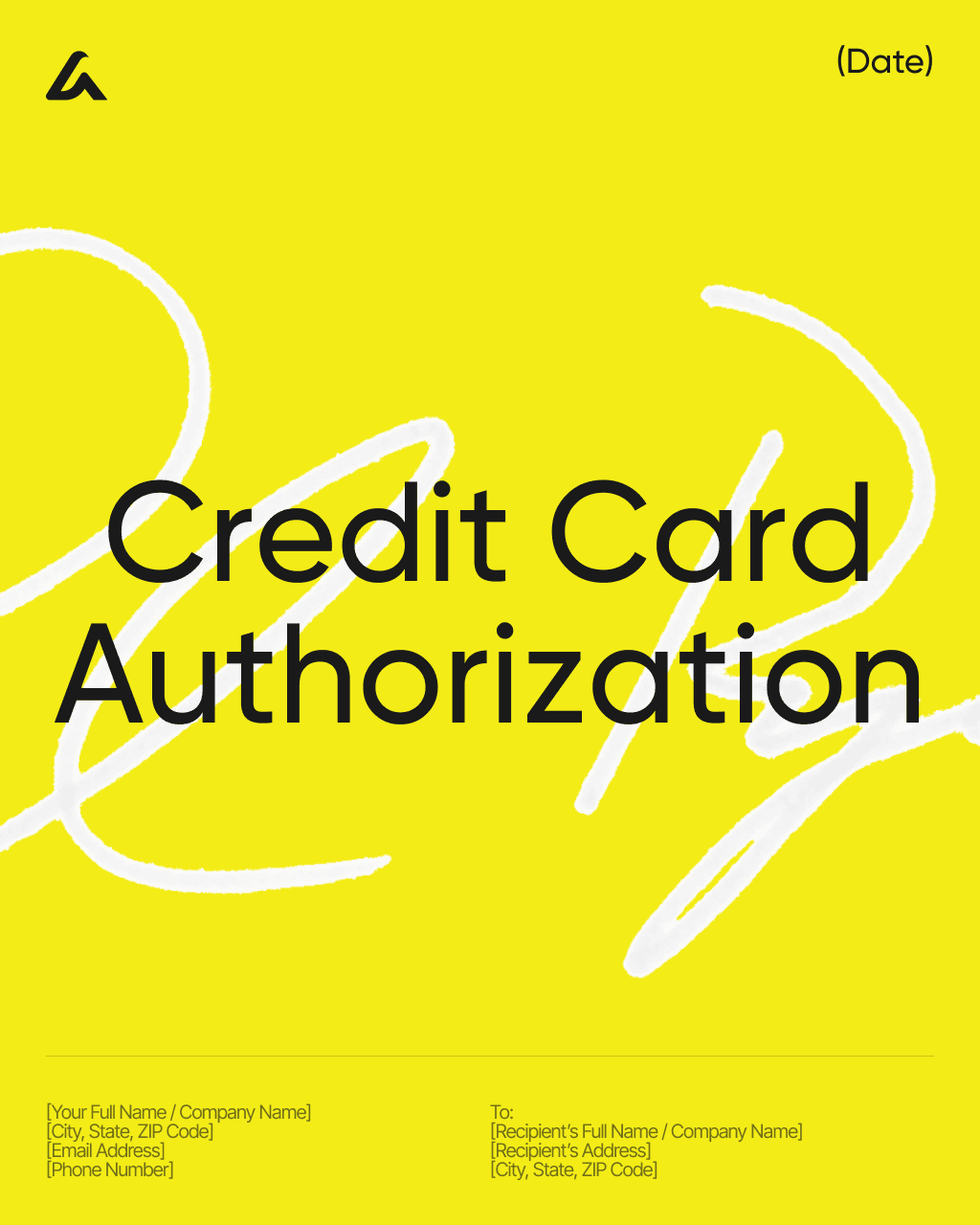
A Credit Card Authorization Template is a formal document that allows a business to charge a customer’s credit card for a one-time transaction or recurring payments. Its purpose is to obtain written permission from the cardholder, reducing the risk of chargebacks, fraud disputes, and unauthorized transactions. This document is commonly used by service providers, medical offices, subscription-based businesses, landlords, and contractors who require pre-approved payment details before delivering services or goods.
Using a standardized Credit Card Authorization template ensures that all essential information is captured—such as cardholder name, card number (partially redacted), expiration date, billing address, the amount authorized, purpose of the charge, and whether the authorization is single-use or recurring. The template may also include consent for storing payment information, cancellation terms, refund policies, and compliance statements for PCI-DSS data security standards. AI-powered tools like AI Lawyer help businesses create secure, customizable, and legally compliant authorization forms that protect both the business and the customer. The result is a clear, enforceable document that supports smooth payment processing, minimizes financial risk, and strengthens professional credibility.
Download Template: Credit Card Authorization Template
For more information please refer to our article: Payment Agreement Templates: U.S. Payment Terms for Any Scenario
Or create your own document yourself with the help of AI.
1.34 Debt Repayment Agreement Template

A Debt Repayment Agreement is a formal contract that outlines the terms under which a borrower agrees to repay an outstanding debt to a lender. It clearly specifies the repayment schedule, total amount owed, interest (if applicable), and consequences for late or missed payments. This document is commonly used when restructuring an existing debt, settling overdue balances, or setting up a repayment plan to avoid collections, legal action, or further financial disputes. Its purpose is to create a clear, legally binding framework that protects both parties and ensures predictable, enforceable repayment terms.
Using a standardized Debt Repayment Agreement template ensures that all essential terms are fully documented—such as the principal balance, interest rate, installment amounts, due dates, acceptable payment methods, default provisions, and acceleration clauses (where the entire balance becomes due upon breach). The template may also include optional components such as collateral pledges, co-signer obligations, waiver of claims, early payoff terms, and dispute resolution procedures. AI-powered tools like AI Lawyer help lenders, businesses, and individuals generate precise, compliant, and customizable repayment agreements that reduce misunderstandings, minimize legal risk, and support smooth debt resolution. The result is a clear, enforceable agreement that promotes accountability and financial stability for both parties.
Download Template: Debt Repayment Agreement Template
For more information please refer to our article: Payment Agreement Templates: U.S. Payment Terms for Any Scenario
Or create your own document yourself with the help of AI.
1.35 Demand Letter for Payment Template

A Demand Letter for Payment is a formal written notice sent to an individual or business to request repayment of an overdue debt or outstanding balance. It serves as an official reminder and a final warning before initiating further action such as collections, mediation, or legal proceedings. The letter outlines the amount owed, the basis of the debt, past attempts to collect, and a clear deadline for payment. Its purpose is to encourage voluntary compliance, preserve evidence of good-faith efforts to resolve the matter, and demonstrate seriousness while remaining professional.
Using a standardized Demand Letter for Payment template ensures that all critical elements are included—such as the total outstanding balance, original due date, invoice or contract references, consequences of nonpayment, and acceptable payment methods. The template may also include sections for late fees, interest, a summary of prior correspondence, supporting documentation, and a statement of intent (e.g., “we will pursue legal action if payment is not received by…"). AI-powered tools like AI Lawyer help individuals and businesses generate clear, assertive, and legally appropriate demand letters tailored to the situation, improving the likelihood of recovering funds without litigation. The result is a professional, well-structured document that communicates urgency while maintaining a firm but respectful tone.
Download Template: Demand Letter for Payment Template
For more information please refer to our article: Payment Agreement Templates: U.S. Payment Terms for Any Scenario
Or create your own document yourself with the help of AI.
1.36 Installment Payment Agreement Template
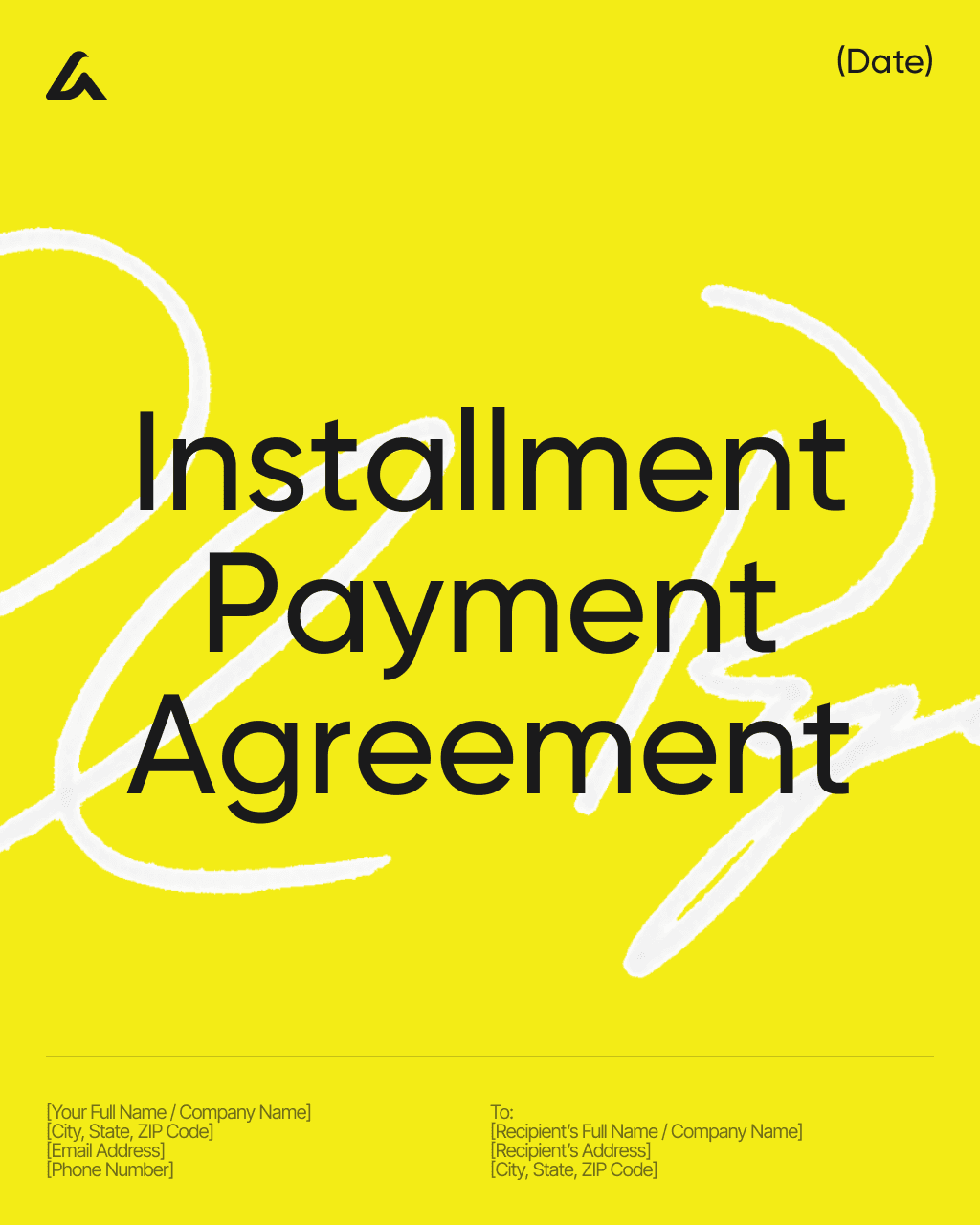
An Installment Payment Agreement is a formal contract that outlines how a borrower or customer will repay a specific debt through scheduled, periodic payments rather than one lump sum. This agreement clearly defines the payment amounts, due dates, total repayment period, interest (if applicable), and consequences of missed or late payments. It is commonly used for personal loans, business debts, settlement arrangements, large purchases, or overdue balances. Its purpose is to create a structured repayment plan that protects the lender’s financial interests while making repayment more manageable for the borrower.
Using a standardized Installment Payment Agreement template ensures that all essential terms are included—such as the principal amount owed, installment schedule, payment method, late fees, default terms, and any acceleration clause that makes the entire balance due if payments are missed. The template may also include optional sections for collateral, co-signer guarantees, early payoff rules, dispute resolution, and governing law. AI-powered tools like AI Lawyer help individuals, lenders, and businesses create precise, clear, and legally compliant installment agreements tailored to their specific repayment arrangements. The result is a professional and enforceable document that reduces misunderstandings, minimizes risk, and provides clarity and accountability for both parties.
Download Template: Installment Payment Agreement Template
For more information please refer to our article: Payment Agreement Templates: U.S. Payment Terms for Any Scenario
Or create your own document yourself with the help of AI.
1.37 Late Payment Agreement Template
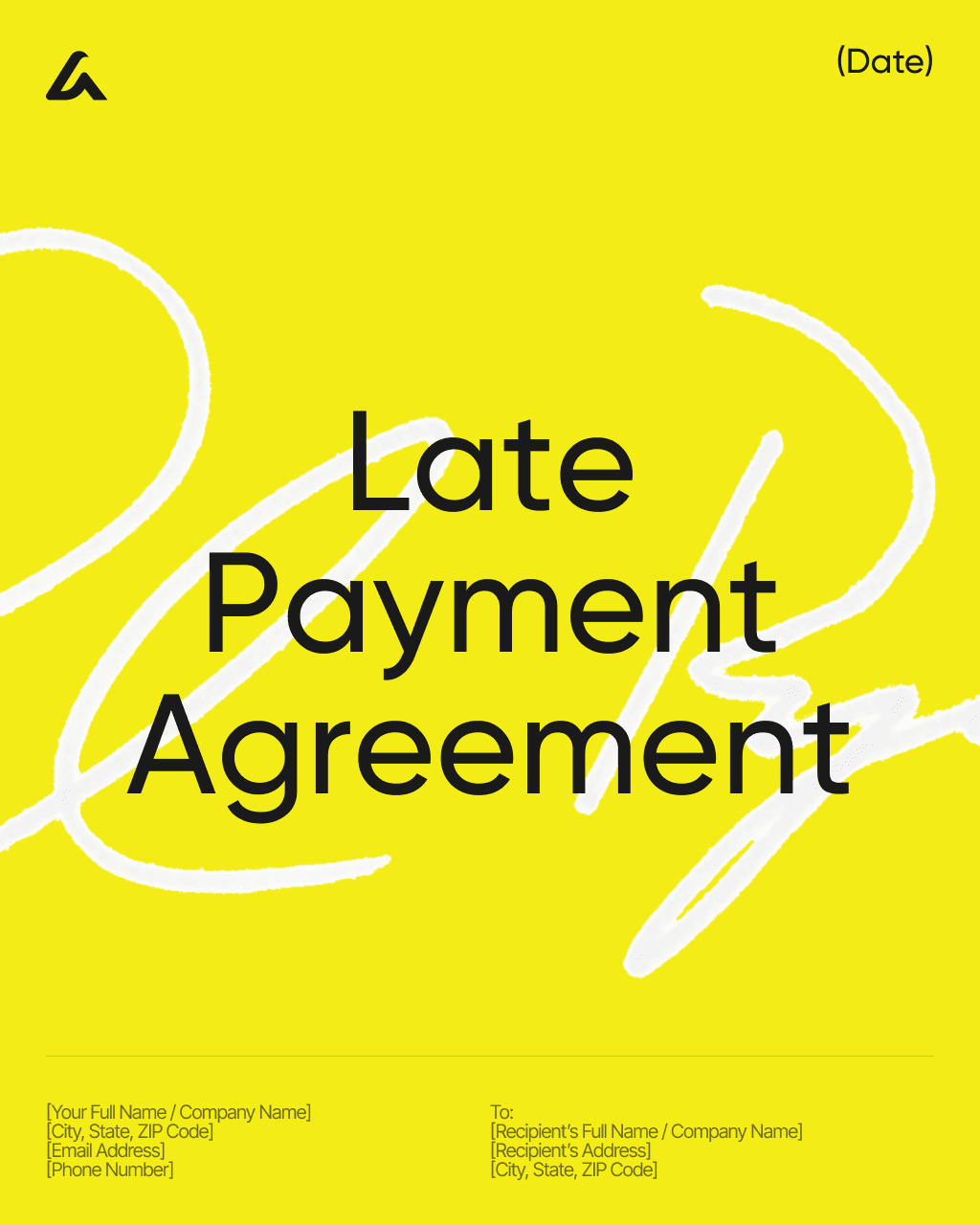
A Late Payment Agreement is a formal contract used when a borrower, customer, or tenant has fallen behind on payments and both parties wish to establish a clear plan to bring the account current. It outlines the overdue balance, new payment terms, deadlines, and any additional fees or conditions imposed due to the lateness. This agreement helps avoid escalation to collections or legal action by giving the delinquent party a structured opportunity to resolve the debt. Its purpose is to document the revised repayment understanding, protect the creditor’s financial interests, and ensure accountability moving forward.
Using a standardized Late Payment Agreement template ensures that all key components are included—such as the outstanding amount, revised due dates, late fees or interest, payment schedule, acceptable payment methods, and consequences for failure to comply with the new terms. The template may also include waiver clauses (e.g., waiving further penalties if payments are made on time), acknowledgment of debt, acceleration clauses, and provisions for terminating the agreement if obligations aren’t met. AI-powered tools like AI Lawyer help businesses, landlords, and lenders create clear, fair, and enforceable agreements that reduce disputes, maintain cash flow, and promote cooperative debt resolution. The result is a professional document that protects both parties and restores structure to a disrupted payment arrangement.
Download Template: Late Payment Agreement Template
For more information please refer to our article: Payment Agreement Templates: U.S. Payment Terms for Any Scenario
Or create your own document yourself with the help of AI.
1.38 Loan Repayment Schedule Template

A Loan Repayment Schedule Template is a structured financial document that outlines how a borrower will repay a loan over time through a series of scheduled payments. It breaks down the total loan amount into installments, showing the due dates, payment amounts, interest allocation, and the remaining balance after each payment. This schedule provides clarity to both the borrower and lender, helping them track progress, anticipate financial obligations, and avoid misunderstandings. It is commonly used for personal loans, business loans, installment agreements, mortgages, and refinancing arrangements.
Using a standardized Loan Repayment Schedule template ensures all critical details are included—such as the principal loan amount, interest rate, amortization structure, payment frequency (weekly, monthly, quarterly), expected payoff date, and any applicable late fees or adjustments. The template may also include an amortization table, interest vs. principal breakdown for each payment, early payoff projections, and fields for additional or extra payments. AI-powered tools like AI Lawyer help borrowers and lenders generate accurate, customized repayment schedules tailored to specific loan terms, reducing calculation errors and providing a clear, professional roadmap for repayment. The result is a transparent, well-organized document that enhances financial planning, supports accountability, and minimizes disputes.
Download Template: Loan Repayment Schedule Template
For more information please refer to our article: Payment Agreement Templates: U.S. Payment Terms for Any Scenario
Or create your own document yourself with the help of AI.
1.39 Partial Payment Agreement Template
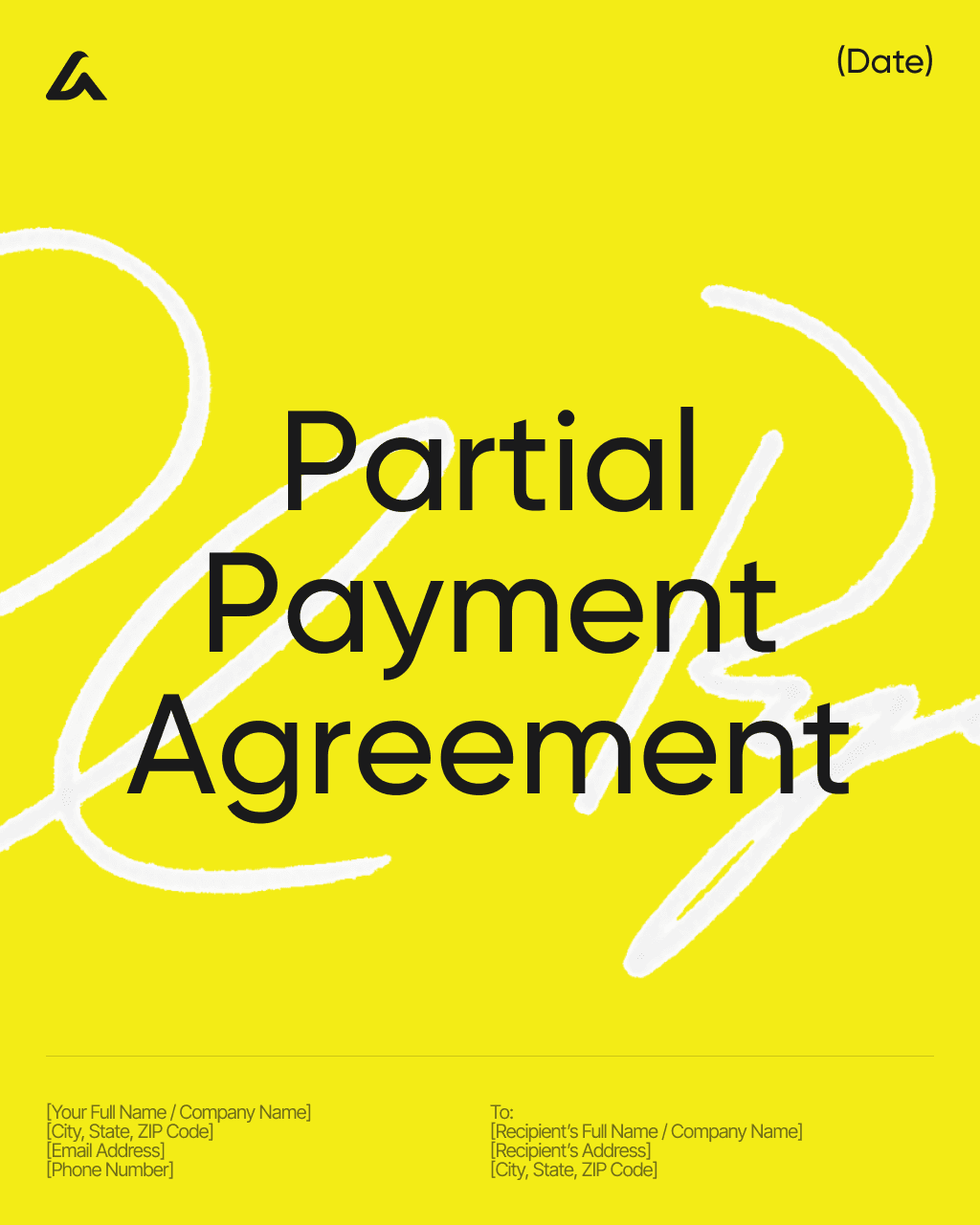
A Partial Payment Agreement is a formal document used when a borrower or customer can pay only a portion of the total amount owed at a given time, and both parties agree on how that partial payment will be applied and how the remaining balance will be handled. This agreement is commonly used in situations involving financial hardship, negotiated settlements, service contracts, rental payments, or overdue invoices. Its purpose is to clearly document the amount being paid now, the remaining balance, and the terms for future payments—reducing misunderstandings and protecting both parties.
Using a standardized Partial Payment Agreement template ensures all essential elements are included—such as the total amount owed, the agreed partial payment amount, payment date, how the partial payment affects the remaining balance, and the timeline or conditions for paying off the rest. The template may also include clauses for interest or late fees, consequences for failing to meet the new terms, waiver or non-waiver of additional penalties, and acknowledgment of the outstanding debt. AI-powered tools like AI Lawyer help individuals and businesses create clear, enforceable, and customizable partial payment agreements, minimizing disputes and promoting smoother financial arrangements. The result is a well-structured contract that protects both parties and ensures transparency in payment expectations.
Download Template: Partial Payment Agreement Template
For more information please refer to our article: Payment Agreement Templates: U.S. Payment Terms for Any Scenario
Or create your own document yourself with the help of AI.
1.40 Payment Arrangement Agreement Template
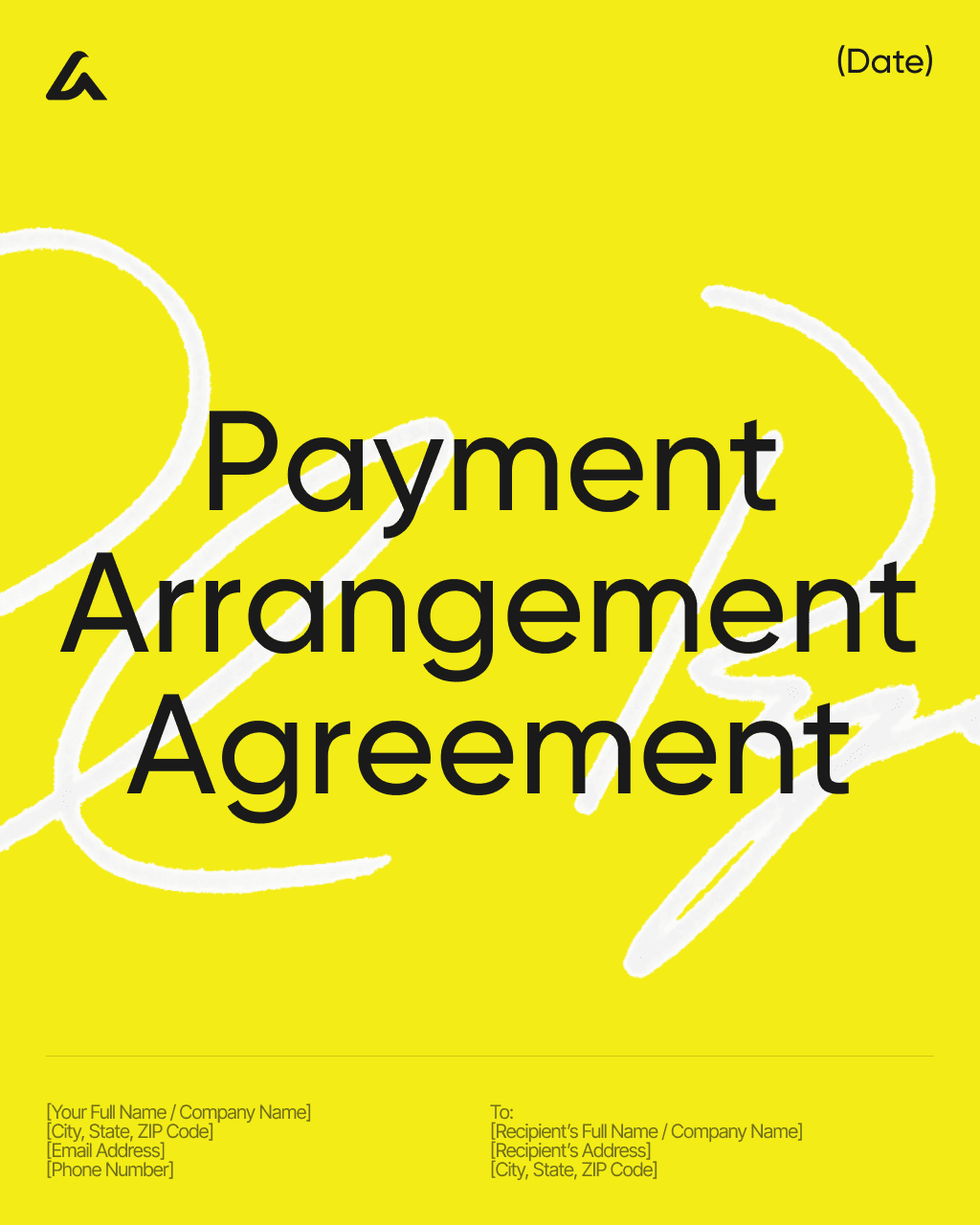
A Payment Arrangement Agreement is a formal contract that outlines a mutually agreed-upon plan for paying an outstanding balance over time. It is commonly used when a borrower, customer, or tenant cannot pay the full amount owed immediately but can make structured payments according to a revised schedule. This agreement protects both parties by creating clarity, preventing misunderstandings, and reducing the need for collections or legal action. Its purpose is to clearly document the total amount due, the payment schedule, and the obligations of each party moving forward.
Using a standardized Payment Arrangement Agreement template ensures that all essential details are included—such as the outstanding balance, installment amounts, due dates, acceptable payment methods, late fees or interest (if applicable), and what happens if the borrower defaults. The template may also include clauses for acceleration of the remaining balance upon breach, negotiated waivers of certain penalties, early payoff terms, co-signer or guarantor obligations, and dispute resolution mechanisms. AI-powered tools like AI Lawyer help businesses, landlords, lenders, and individuals create precise and enforceable payment arrangement agreements tailored to specific financial circumstances. The result is a professional, well-organized document that supports accountability, reduces risk, and provides a clear path for resolving overdue or outstanding debts.
Download Template: Payment Arrangement Agreement Template
For more information please refer to our article: Payment Agreement Templates: U.S. Payment Terms for Any Scenario
Or create your own document yourself with the help of AI.
1.41 Payment Authorization Form Template
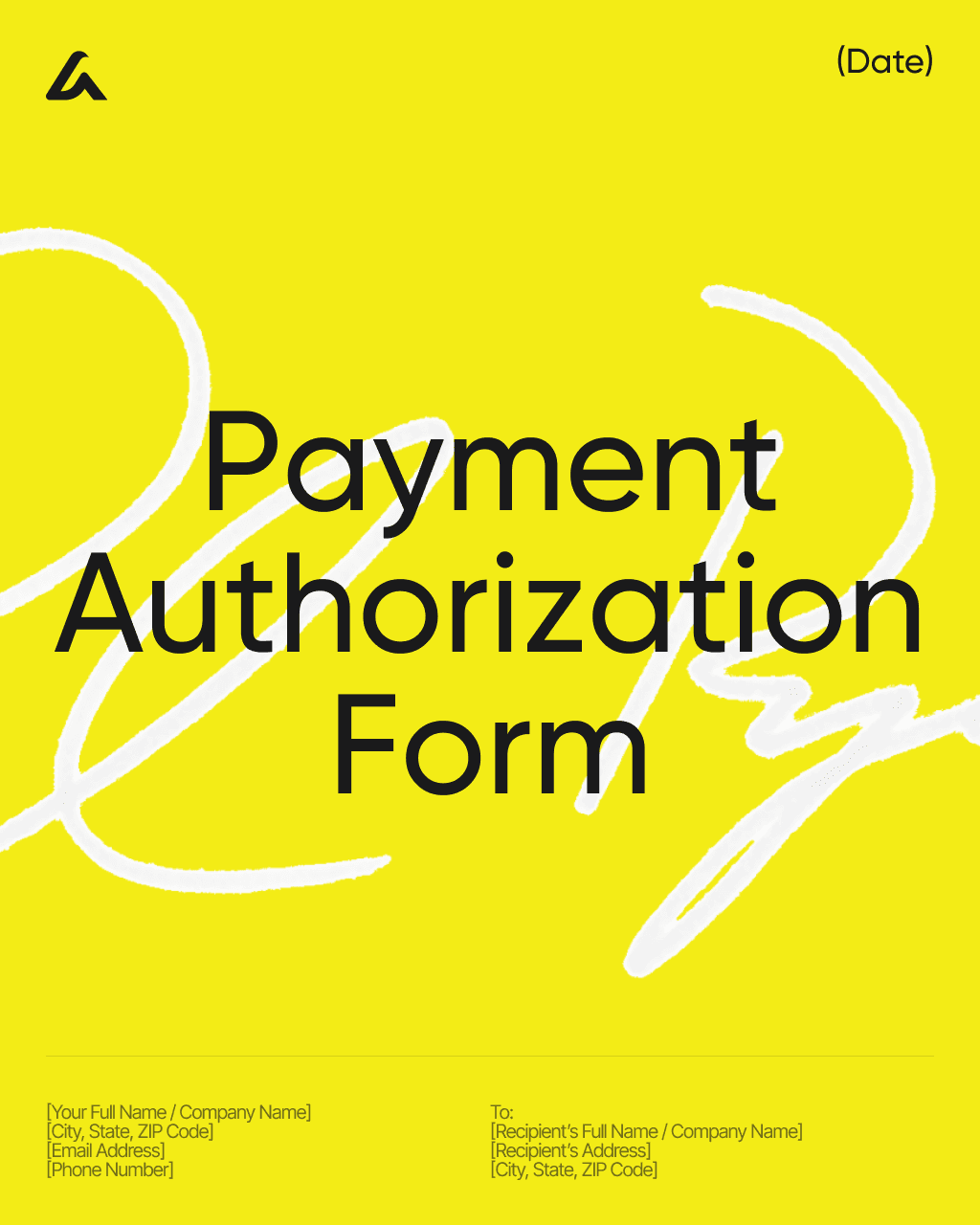
A Payment Authorization Form is a formal document that grants a business permission to charge a customer’s credit card, debit card, or bank account for a one-time or recurring payment. This form protects businesses from unauthorized transaction disputes and ensures customers understand and consent to the charges. It is commonly used by service providers, subscription-based businesses, medical offices, landlords, and any organization that needs secure, documented approval before processing payments.
Using a standardized Payment Authorization Form template ensures all essential information is captured—such as the customer’s name, billing address, payment method, card or account details (often partially redacted for security), authorized amount(s), payment frequency, and the purpose of the charge. The template may also include recurring billing terms, cancellation procedures, refund policies, compliance statements (PCI-DSS for card data security), and explicit customer consent language. AI-powered tools like AI Lawyer help businesses create secure, clear, and legally compliant authorization forms that reduce chargeback risk, streamline billing processes, and improve financial recordkeeping. The result is a professional, enforceable document that protects both the business and the customer while ensuring smooth and transparent payment processing.
Download Template: Payment Authorization Form Template
For more information please refer to our article: Payment Agreement Templates: U.S. Payment Terms for Any Scenario
Or create your own document yourself with the help of AI.
1.42 Payment Guarantee Agreement

A Payment Guarantee Agreement is a formal contract in which a third party (the guarantor) promises to assume responsibility for a borrower’s debt or payment obligations if the borrower fails to pay. This document provides additional security for lenders, landlords, service providers, or businesses entering into financial agreements with customers who may pose a higher risk. Its purpose is to legally bind the guarantor to cover unpaid balances, ensuring that the creditor has a reliable secondary source of repayment.
Using a standardized Payment Guarantee Agreement template ensures that all essential legal elements are included—such as the identities of the borrower, guarantor, and creditor; the amount guaranteed; payment terms; conditions that trigger the guarantee; and the guarantor’s obligations. The template may also include clauses addressing limitations of liability, duration of the guarantee, waiver of defenses, collateral (if applicable), default terms, and governing law. AI-powered tools like AI Lawyer help individuals and businesses draft clear, enforceable guarantee agreements that reduce financial risk, ensure accountability, and provide strong legal protection in case of nonpayment. The result is a comprehensive, professional document that offers peace of mind to creditors and clarifies the guarantor’s responsibilities.
Download Template: Payment Guarantee Agreement
For more information please refer to our article: Payment Agreement Templates: U.S. Payment Terms for Any Scenario
Or create your own document yourself with the help of AI.
1.43 Recurring Payment Agreement Template
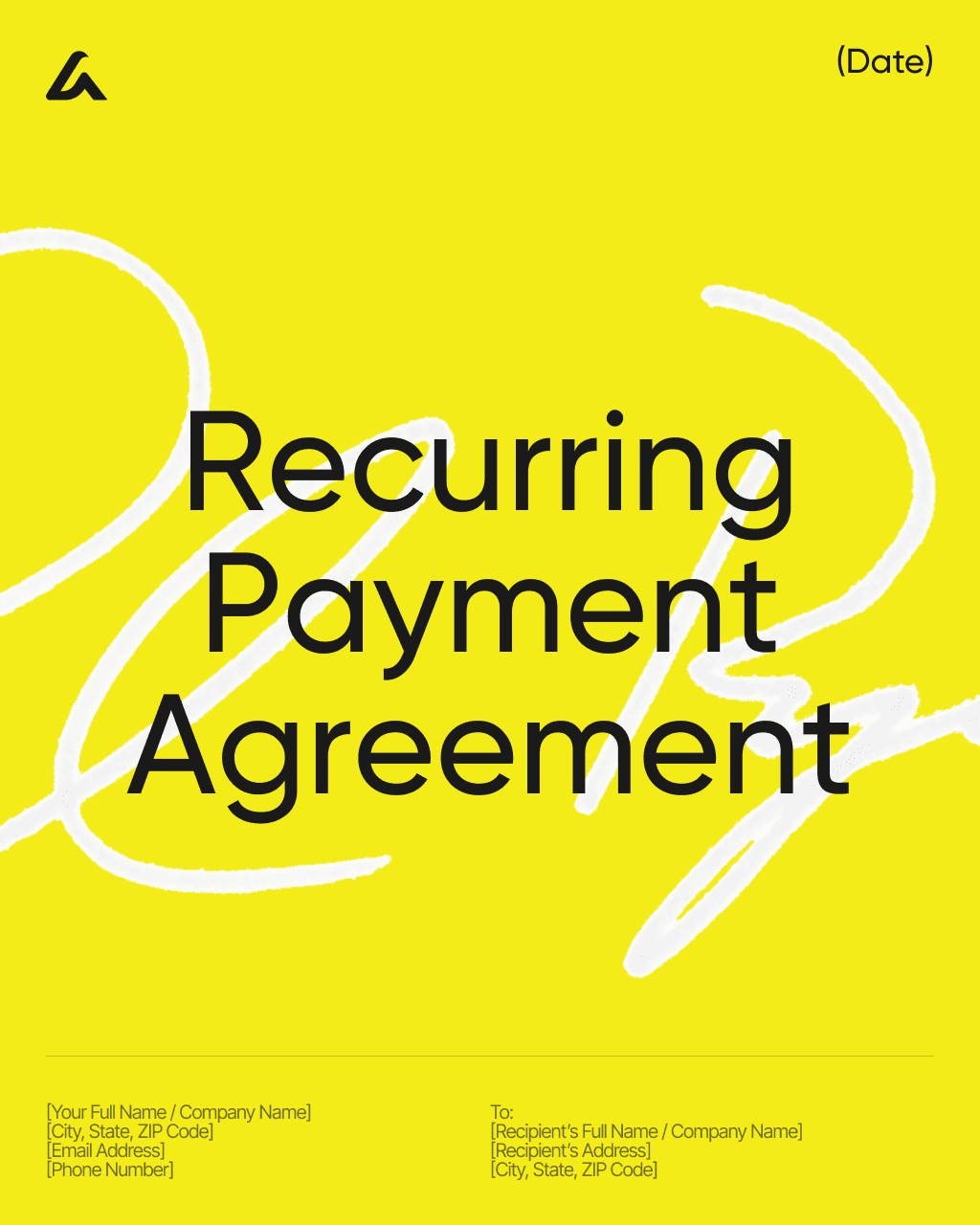
A Recurring Payment Agreement is a formal contract that authorizes a business to automatically charge a customer on a regular basis—such as weekly, monthly, quarterly, or annually—for ongoing services, subscriptions, memberships, rent, or installment payments. Its purpose is to clearly outline the billing schedule, payment amounts, authorization terms, and cancellation procedures, ensuring transparency and preventing disputes. This agreement protects both the business and the customer by defining expectations and establishing legal consent for repeated charges.
Using a standardized Recurring Payment Agreement template ensures that all key components are included—such as the customer’s billing information, frequency of payments, authorized amount or variable billing terms, start and end dates, refund or cancellation policies, and any applicable late fees or penalties. The template may also include clauses addressing updates to payment methods, automatic renewal terms, data security requirements (PCI-DSS), dispute resolution, and the customer’s right to revoke authorization. AI-powered tools like AI Lawyer help businesses create clear, compliant, and user-friendly recurring payment agreements that reduce chargeback risk, streamline billing processes, and support long-term customer relationships. The result is a professional, enforceable agreement that ensures predictable revenue and smooth ongoing payment operations.
Download Template: Recurring Payment Agreement Template
For more information please refer to our article: Payment Agreement Templates: U.S. Payment Terms for Any Scenario
Or create your own document yourself with the help of AI.
1.44 Service Payment Agreement Template
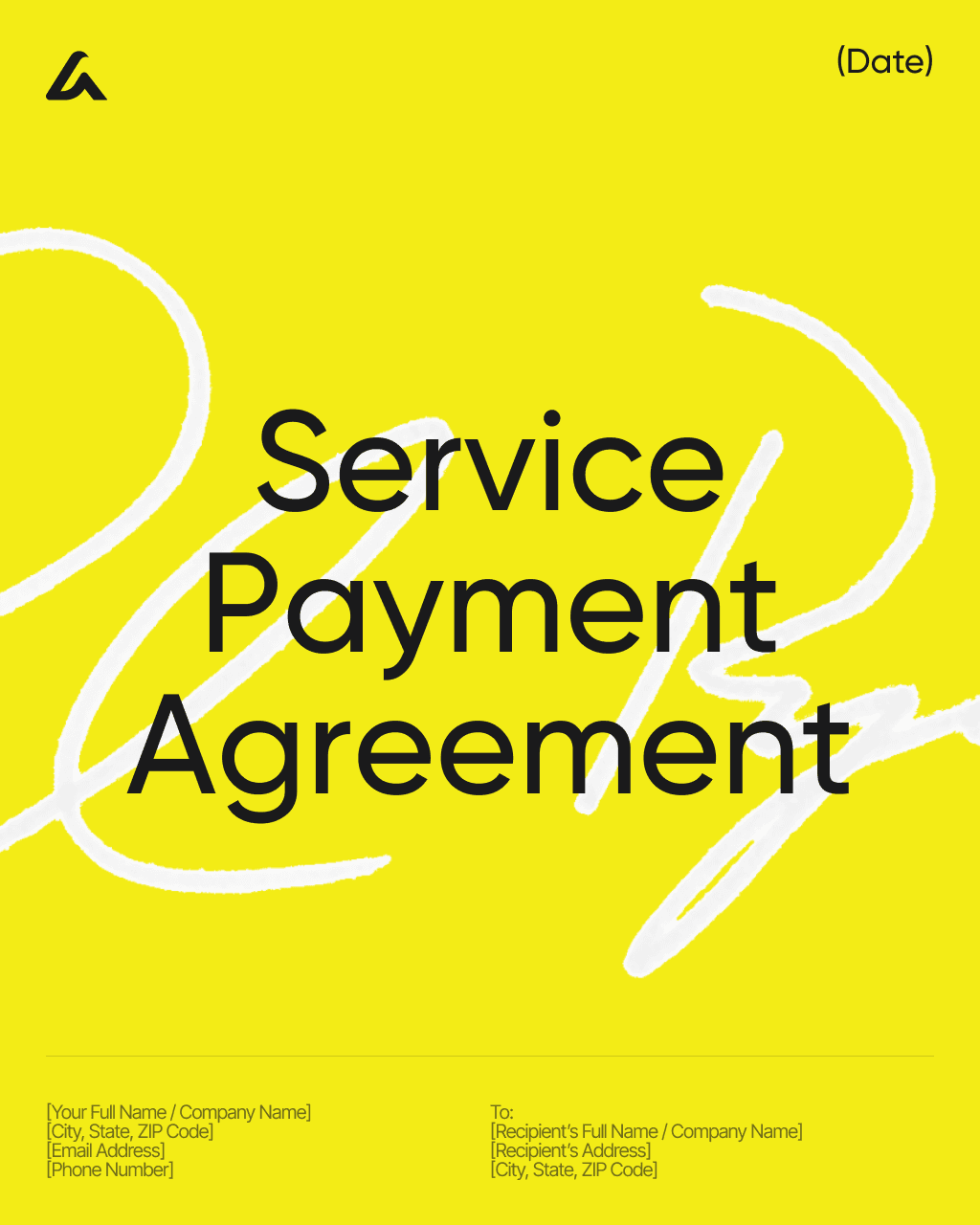
A Service Payment Agreement is a formal contract that outlines the payment terms for services rendered by an individual or business. It specifies what services will be provided, how much the client will pay, when payments are due, and what happens if the client fails to pay. This agreement is commonly used by freelancers, contractors, consultants, agencies, and service-based businesses to establish clear financial expectations before work begins. Its purpose is to prevent misunderstandings, protect both parties, and ensure the service provider is compensated fairly and on time.
Using a standardized Service Payment Agreement template ensures that all essential components are included—such as the scope of services, rate structure (hourly, flat fee, milestone-based), payment schedule, invoices and due dates, late payment penalties, refund policies, and terms for modifying or terminating the agreement. The template may also include clauses related to intellectual property rights, confidentiality, dispute resolution, and governing law. AI-powered tools like AI Lawyer help service providers create customizable, professional agreements tailored to their industry and workflow, reducing the risk of payment issues or contractual conflicts. The result is a clear, enforceable document that strengthens business relationships and supports smooth service delivery.
Download Template: Service Payment Agreement Template
For more information please refer to our article: Payment Agreement Templates: U.S. Payment Terms for Any Scenario
Or create your own document yourself with the help of AI.
1.45 Terms of Payment Template
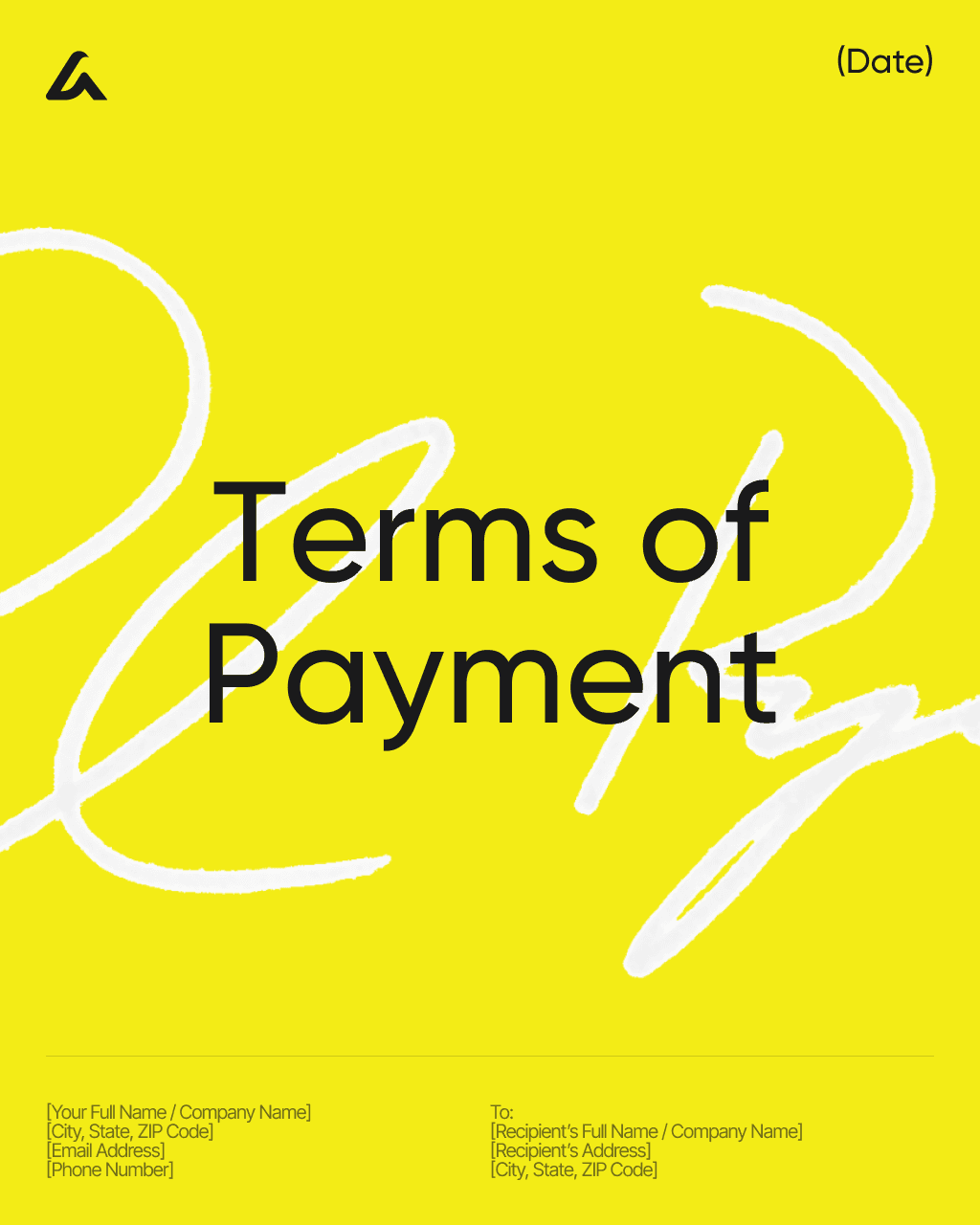
A Terms of Payment Template is a structured document that defines how and when a customer or client must pay for goods or services. It outlines the financial rules governing a transaction, ensuring both parties clearly understand payment expectations before entering into a business relationship. These terms are commonly included in contracts, invoices, service agreements, and sales documents. The purpose of the Terms of Payment is to protect the business’s cash flow, set clear deadlines, minimize payment disputes, and establish consequences for late or missed payments.
Using a standardized Terms of Payment template ensures all essential details are covered—such as payment due dates, accepted payment methods, installment options, late fees or interest, early payment discounts, invoice procedures, and penalties for nonpayment. The template may also include clauses relating to refunds, chargebacks, currency conversion, tax obligations, and how payment-related disputes will be handled. AI-powered tools like AI Lawyer help businesses create precise, professional, and customizable payment terms that align with their industry standards and legal requirements. The result is a clear and enforceable set of conditions that reduces misunderstandings, strengthens financial accountability, and supports smoother business transactions.
Download Template: Terms of Payment Template
For more information please refer to our article: Payment Agreement Templates: U.S. Payment Terms for Any Scenario
Or create your own document yourself with the help of AI.
📘 Overview: Which Financial Agreement Template Should You Use?
Not sure whether you need a Promissory Note, a Loan Agreement, or a Payment Agreement? Each document in the Financial Agreements category serves a distinct purpose — from defining repayment terms to formalizing debt settlements. These templates help structure clear, enforceable financial relationships while minimizing the risk of disputes and misunderstandings.
The table below explains when to use each type, what key components to include, and which legal considerations to keep in mind to stay compliant and protected. Use it as your quick reference guide when choosing the right financial agreement template — ensuring every loan, repayment plan, or financial commitment is properly documented and legally sound.
Template | Use Case (When to Use) | Typical Components | Key Legal/Professional Considerations |
|---|---|---|---|
Used when a borrower promises to repay a specified amount to a lender, usually for simple, unsecured loans. | Parties identification; principal amount; interest rate; repayment terms (schedule, amount, due dates); maturity or demand clause; signatures. | Ensure clear repayment and interest terms; include governing law; often unsecured, so consider adding security for large sums. | |
Used to formalize payment plans for existing debts or obligations, often in restructuring or settlements. | Description of debt; total amount owed; payment schedule; interest or late fees; default remedies; governing law. | Clarify payment allocation (principal, interest, fees); define default remedies; ensure compliance with consumer protection laws. | |
When lending money between individuals or institutions and individuals requiring detailed terms, often with collateral. | Loan amount; interest rate; repayment schedule; security/collateral details; default consequences; prepayment terms; warranties; governing law. | Specify collateral and perfect security interests properly to protect lender. Define default triggers clearly to enable enforcement. Ensure interest rates comply with usury laws. Include dispute resolution clauses to handle conflicts effectively. | |
Formal contract for larger or business loans, often secured with collateral and comprehensive terms. | Loan amount; disbursement details; interest rates; repayment and grace periods; security/collateral; borrower warranties; default events; covenants; governing law. | Must clearly detail default and remedy procedures. Proper collateral documentation and perfection essential for enforceability. Include borrower obligations and restrictions to manage risk. Legal compliance with lending regulations mandatory, including licensing and usury laws. | |
Used when an individual guarantees another party’s debt or performance obligations, often in business loans or leases. | Guarantee terms; scope of liability; waiver clauses; duration; governing law; signatures. | Specify whether guarantee is limited or unlimited; include waiver of defenses; ensure guarantor understands obligations. | |
Used to amend the terms of an existing loan, adjusting repayment, interest, or collateral terms. | Original loan reference; modified terms; effective date; acknowledgment of continuing obligations; signatures. | Ensure mutual consent and clarity of modified clauses; document lender’s rights; comply with state modification notice rules. | |
Used to grant a lender a security interest in collateral to secure repayment of a debt. | Description of collateral; secured obligations; borrower covenants; default and remedies; governing law. | Must comply with UCC Article 9 filing; include perfection and priority clauses; describe collateral precisely. | |
Used in real estate financing to secure property as collateral for a loan. | Property description; trustee designation; borrower and lender details; power of sale clause; repayment obligations. | Ensure proper recording in county records; comply with foreclosure laws; clearly define trustee powers. | |
Used to summarize revenues, costs, and expenses over a financial period. | Income and expense categories; gross profit; net income; reporting period; notes or adjustments. | Ensure GAAP or IFRS compliance; accuracy critical for investors and tax filings; include verification statement. | |
Used to document voluntary transfers of money or property to a recipient organization. | Donor and recipient details; donation amount or item; purpose; acknowledgment; restrictions or conditions. | Clarify tax-deductible status; ensure conditions align with nonprofit laws; include clause for donor intent. | |
Used to collect financial and credit information before extending credit or loans. | Applicant details; business or personal financial info; credit references; consent for credit check; signature. | Must comply with FCRA and privacy laws; obtain explicit consent for credit inquiries; store data securely. | |
Used to resolve and settle outstanding debts for a reduced amount. | Debt description; settlement amount; payment terms; release of liability; governing law. | Include mutual release clauses; ensure clear payment schedule; confirm that settlement satisfies all claims. | |
Used between energy producers and buyers to define terms of electricity sale. | Energy quantity; pricing method; term length; delivery obligations; termination clauses. | Ensure regulatory compliance (PUC, FERC); specify performance standards; address force majeure and liability. | |
Used to authorize recurring electronic payments from a customer’s bank account. | Payer and payee details; bank account info; authorization statement; frequency and amount; signature. | Must comply with NACHA rules; include revocation rights; provide copy to customer. | |
Used by startups to raise funds, granting investors future equity without debt. | Investment amount; valuation cap or discount; conversion terms; governing law; representations. | Clarify conversion triggers; ensure SEC exemption compliance; disclose investor risks clearly. | |
Used when funds or property are held by a neutral third party until conditions are met. | Escrow agent details; release conditions; responsibilities; fees; dispute resolution. | Define release triggers precisely; ensure escrow agent’s liability limits; comply with KYC/AML requirements. | |
Used to define rights and priorities between multiple lenders to the same borrower. | Parties; lien priorities; payment waterfalls; default handling; governing law. | Ensure clear ranking of claims; include standstill and enforcement clauses; align with UCC perfection rules. | |
Used to grant investors specific rights post-investment, such as information or board rights. | Information rights; registration rights; preemptive rights; drag/tag-along clauses. | Ensure SEC compliance; balance investor rights with founder control; update after subsequent funding rounds. | |
Used in crypto projects to raise funds for future token issuance. | Token delivery terms; purchase amount; vesting or release schedule; regulatory acknowledgments. | Ensure compliance with SEC and FinCEN guidance; define token utility vs. security; include risk disclosures. | |
Used to issue company stock subject to vesting or performance conditions. | Share grant details; vesting schedule; repurchase rights; tax election notice (83(b)); governing law. | Address tax implications; include forfeiture conditions; ensure board approval and cap table updates. | |
Used to outline terms for awarding funds for a specific project or purpose. | Grant amount; milestones; reporting requirements; permitted uses; termination clauses. | Include accountability and audit clauses; ensure funds used per donor restrictions; clarify ownership of results. | |
Used in early-stage financing where debt may convert into equity at a later date. | Purchase amount; interest rate; conversion mechanics; maturity date; governing law. | Ensure compliance with securities laws; clarify valuation cap and discount; document investor rights. | |
Used to establish that one creditor’s claim ranks below another’s in repayment priority. | Subordination terms; consent of creditors; payment restrictions; governing law. | Must be executed by all relevant creditors; clarify enforcement limits; align with loan covenants. | |
Used for asset sales with installment payments and collateral security. | Purchase price; installment schedule; security interest details; title retention; remedies. | Ensure compliance with UCC Article 9; outline repossession rights; clarify transfer of title timing. | |
Used for loans with smaller periodic payments followed by a large final payment. | Principal amount; interest rate; installment schedule; balloon payment date and amount; default terms. | Clarify balloon payment obligations; ensure borrower understands refinancing or payoff options; disclose total cost. | |
Used when a lender may demand repayment at any time instead of on a fixed schedule. | Principal amount; interest rate; demand terms; prepayment rights; governing law. | Specify notice requirements; ensure compliance with usury laws; document conversion or renewal options clearly. | |
Used to assure a lender that a third party will fulfill obligations if the borrower defaults. | Guarantee terms; obligations covered; waivers; enforcement clauses; signatures. | Include waiver of defenses; specify governing law; define scope (limited or continuing) to prevent disputes. | |
Used to obtain credit data from institutions or clients before transactions. | Applicant info; requested details; authorization for release; confidentiality statement. | Must comply with privacy and FCRA rules; ensure secure data handling; include consent documentation. | |
Used to resolve billing or debt disputes between parties. | Disputed amount; settlement payment terms; mutual release; governing law. | Include release of claims; ensure clear payment obligations; confirm finality to prevent future disputes. | |
When a client pays part or all of the service cost upfront. | Advance amount; payment schedule; refund terms; scope of work; cancellation terms. | Clarify whether advance is refundable; protect business against cancellations; define ownership of work if terminated. | |
When formalizing a borrower’s promise to repay a debt. | Total amount owed; payment plan; interest; deadlines; default terms; signatures. | Ensure enforceability; specify remedies for nonpayment; may require notarization for large debts. | |
For ongoing or recurring billing arrangements. | Billing cycle; rates/fees; auto-pay terms; refund policy; authorization. | Must comply with consumer protection laws; clearly disclose recurring charges; PCI-DSS rules if storing card data. | |
Allows a business to charge a customer's credit card. | Cardholder info; card details (partially redacted); authorized amount; purpose; recurring/one-time terms. | Must follow PCI-DSS security standards; protect sensitive data; clear consent required to avoid chargebacks. | |
To formalize repayment of existing debts over time. | Balance owed; interest; installment schedule; penalties; acceleration clause. | Ensure clear interest disclosures; comply with lending laws; document borrower acknowledgment of debt. | |
Used before legal action to demand overdue payment. | Amount owed; due date; contract/invoice references; deadline for payment; consequences. | May serve as evidence in court; tone should be firm but professional; avoid unlawful threats. | |
When allowing a borrower to repay in scheduled installments. | Installment amounts; schedule; interest; late fees; default remedies. | Should outline acceleration rights; ensure compliance with state lending/consumer laws. | |
When renegotiating terms after a borrower falls behind. | Overdue balance; revised due dates; penalties; reinstatement terms. | Must avoid coercive terms; clarify whether penalties are waived or preserved; ensure fairness. | |
To outline repayment structure for a loan. | Amortization table; interest rate; payment dates; principal vs interest breakdown. | Must reflect accurate calculations; ensure transparency for regulated loans. | |
When borrower pays only part of the owed amount now. | Partial payment amount; updated balance; future payment terms; acknowledgment of debt. | Specify whether paying part waives rights; clarify that remaining balance is still owed; avoid ambiguity. | |
When restructuring payments to avoid collections/legal action. | Total owed; new schedule; terms for compliance; consequences of default. | Important for documenting borrower consent; ensure terms comply with debt collection laws. | |
Allows a business to charge a customer’s card or bank account. | Customer info; payment method; authorized amount(s); frequency; consent language. | Must comply with PCI-DSS or banking rules; prevent unauthorized charges; clearly define cancellation rights. | |
When a third party guarantees repayment if the borrower defaults. | Guarantor obligations; guaranteed amount; triggers for guarantee; liability limits. | Highly binding; guarantor may need independent legal advice; ensure waiver-of-defense clauses are clear. | |
For subscriptions or services billed on an ongoing basis. | Billing frequency; recurring amount; renewal terms; cancellation rules. | Automatic renewals must follow consumer protection laws; must disclose recurring billing clearly. | |
When defining payment terms for professional services. | Service scope; fees; payment schedule; refunds; termination terms. | Ensure clarity of deliverables; include dispute resolution; protect intellectual property. | |
To define payment rules in contracts or invoices. | Due dates; accepted methods; late fees; discounts; penalties; refund rules. | Must comply with invoicing and tax laws; enforceability depends on visibility and acceptance. |
2. Regional Requirements & Nuances (Financial Agreements)
Financial agreements must reflect state-specific rules on privacy, fair dealing, disclosures, auto-renewals, interest/usury, and e-signatures. Below: what to include (and avoid) in proposals and contracts across the key U.S. jurisdictions we’re using.
2.1 West Coast: California & Washington
California — CPRA, plain-language terms, and auto-renewal
Actual Documents: Financial Services Agreement, MSA + SOW, DPA/Processor Addendum, Subscription/Auto-Renewal Terms.
Requirements and nuances:
Privacy: if you process Californians’ personal/financial data, state compliance with the CCPA/CPRA and sign a DPA when acting as a processor; include Notices of Financial Incentive when offering perks for data per Civ. Code §1798.125.
Fairness: overbroad “no-liability” clauses conflict with Civil Code §1668; avoid hidden fees under UCL/CLRA. For financial or lending arrangements, a Personal Loan Agreement — California ensures all obligations, rates, and limitations are presented transparently to stay compliant with §1668 and consumer fairness rules.
Auto-renewal: use clear, conspicuous disclosure, affirmative consent, easy cancellation, and renewal/price-change notices under the AG’s Auto-Renewal Law guidance.
Common Searches: “California CPRA DPA clause”, “California ARL disclosure template”.
Common Mistakes: Hidden “junk fees”; missing Notice of Financial Incentive; sweeping liability waivers that violate §1668.
How AI Lawyer helps: Inserts CPRA-ready privacy terms and DPA language, generates ARL-compliant summary boxes + cancellation flow, flags risky limitation-of-liability wording. When billing or subscriptions involve recurring charges, a Payment Agreement — California helps set renewal terms, consent language, and clear cancellation procedures that meet ARL standards.
Washington — renewal reminders and health-data sensitivity
Actual Documents: Financial Services Agreement, Privacy Addendum, Subscription Terms, Consent Notices.
Requirements and nuances:
Renewal reminders: for long-term subscriptions, add advance notices as required by Washington’s auto-renewal rules (see RCW 19.386). When recurring charges are involved, a Payment Agreement — Washington helps define billing cycles, notice timing, and cancellation terms in line with RCW 19.386.
Health-adjacent data: if your product touches wellness/health signals, obtain opt-in consent and honor deletion/limit uses under the My Health My Data Act.
Deceptive practices are barred by the Consumer Protection Act. For financial or credit-based relationships, a Personal Loan Agreement — Washington ensures disclosures and repayment terms meet CPA transparency standards and protect both sides.
Common Searches: “Washington auto-renewal reminder timing”, “My Health My Data consent language”.
Common Mistakes: No renewal reminder for annual plans; treating health-adjacent telemetry as non-health data.
How AI Lawyer helps: Adds WA-specific consent text, renewal-notice schedule language, and CPA-safe fee disclosures.
2.2 Northeast: New York
Actual Documents: Financial Agreement, MSA + SOW, Consumer Terms, Security & Privacy Addendum.
Requirements and nuances:
Plain language: consumer contracts should meet the Plain Language Law (GOL §5-702)—clear words, readable layout.
No deception: avoid hidden fees/overpromises under GBL §349. For lending or credit arrangements, a Personal Loan Agreement — New York ensures interest rates, fees, and repayment terms are fully disclosed, keeping the contract compliant with GBL §349. A Payment Agreement — New York helps formalize deliverables, payment schedules, and timing to align with the Freelance Isn’t Free Act and ensure timely compensation.
Security posture: acknowledge “reasonable safeguards” and breach readiness under the AG’s SHIELD Act.
NYC freelancers: proposals functioning as contracts should include written terms and timely pay to fit the Freelance Isn’t Free Act.
Common Searches: “NY plain-language contract checklist”, “GBL §349 deceptive fees”.
Common Mistakes: Tiny fonts/long legalese blocks; vague APR/fee breakdowns; hand-wavy security claims.
How AI Lawyer helps: Produces a plain-English version automatically, inserts transparent fee tables, and appends a light security appendix aligned to SHIELD expectations.
2.3 Southern States: Texas & Florida
Texas — new privacy law + classic usury/disclosure rules
Actual Documents: Financial Agreement, DPA/Processor Addendum, Website/App Privacy Policy, Disclosure Schedules.
Requirements and nuances:
Privacy: from July 2024, include consumer-rights and processor terms under the Texas Data Privacy and Security Act. If you collect PII online from Texans, post a privacy policy per Bus. & Com. Code §521.052.
Pricing/interest: respect interest-rate caps and disclosures in Finance Code §302. A Personal Loan Agreement — Texas clearly outlines interest rates, repayment terms, and disclosure language, helping lenders comply with §302 and avoid accidental usury violations.
No deception: avoid hidden fees/unfair terms under the DTPA. For service or subscription models, a Payment Agreement — Texas sets out transparent billing terms and protects both parties from DTPA claims related to hidden charges.
Common Searches: “Texas TDPSA processor obligations”, “Texas usury cap §302”.
Common Mistakes: Missing DPA while acting as a processor; fuzzy controller/processor roles; unclear APR/fees.
How AI Lawyer helps: Auto-classifies roles, drops in TDPSA clauses + consumer-rights workflow, and generates clear payment/interest tables.
Florida — Digital Bill of Rights, refunds, and marketing consent
Actual Documents: Financial Agreement, Privacy & Marketing Consent Addendum, Refund/Returns Policy (if retail/e-comm), Subscription Terms.
Requirements and nuances:
Privacy: for large platforms, the Florida Digital Bill of Rights requires transparency, data rights, and limits on certain algorithmic uses—good practice signals for everyone else too.
UDTPA: avoid unfair/deceptive practices under FDUTPA §501.204. For lending or credit-based transactions, a Personal Loan Agreement — Florida clarifies interest, repayment, and disclosure terms to align with FDUTPA fairness standards and prevent deceptive-practice exposure.
Refunds: either post a refund policy or default rules apply under §501.142. When handling recurring billing or cancellations, a Payment Agreement — Florida helps define refund triggers, timing, and payment methods in a way consistent with §501.142 requirements.
Outreach: obtain consent for calls/texts under §501.059.
Common Searches: “Florida refund sign requirement”, “Florida mini-TCPA consent”.
Common Mistakes: Dark patterns in renewals/cancellations; no visible refund policy; SMS outreach without provable consent.
How AI Lawyer helps: Adds FDBR-aligned consent/opt-out language, a clean refund policy block, and compliant telemarketing/SMS consent capture.
2.4 Midwest: Illinois
Actual Documents: Financial Agreement, Biometric Consent + Retention Policy, AI/Automated Decision-Making Notice, DPA.
Requirements and nuances:
Biometrics: obtain written informed consent and publish retention/destruction policies under BIPA (740 ILCS 14).
AI in hiring/assessments: provide notice, explanation, and consent where applicable (see the AI Video Interview Act). Where hiring, service, or incentive payments are automated, a Payment Agreement — Illinois can document rates, timing, and transparency standards to ensure fairness under evolving AI-related laws.
Security & fairness: breach duties under PIPA (815 ILCS 530); deceptive practices barred by the Consumer Fraud Act (815 ILCS 505). A Personal Loan Agreement — Illinois helps clarify financial obligations, interest terms, and consumer rights in a way that aligns with the fairness principles of the Consumer Fraud Act.
Common Searches: “Illinois BIPA consent form”, “AI Video Interview notice text”.
Common Mistakes: Biometric login without separate consent; no retention schedule; vague penalty clauses that read as unconscionable.
How AI Lawyer helps: Generates a BIPA pack (consent + public retention policy + contract clauses), adds AI transparency notices, and threads data-security promises into the SOW and privacy policy.
Summary
California & Washington: privacy-first, strict auto-renewal transparency, and no hidden fees.
New York: plain-language contracts and strong anti-deception enforcement.
Texas & Florida: modern privacy mechanics + classic fair-dealing (usury, refunds, marketing consent).
Illinois: biometric/AI transparency with high litigation exposure.
AI Lawyer auto-tailors each template by state, injecting the right privacy terms, renewal/consent mechanics, disclosures, and enforceable liability language—so your financial agreements are compliant, clear, and ready to sign.
3. Legal & Industry Updates (2024–2025) Affecting Financial Agreements
Keeping your financial agreement templates current with evolving laws and industry trends is critical for maintaining legal compliance, minimizing risk, and fostering trust with clients. The years 2024 and 2025 have introduced numerous significant regulatory and technological developments that directly impact how financial agreements should be drafted, negotiated, and executed. This section breaks down the most important updates related to consumer protection, usury laws, data privacy, and the growing influence of AI and automation in loan processing and financial services.
3.1 📍 Consumer Protection and Usury Laws
Regulators are taking aim at hidden costs and misleading pricing. The FTC’s “Click-to-Cancel” rule (effective late 2024) requires that ending a subscription or service be as easy as signing up, while the upcoming “Junk Fees” rule (expected 2025) bans undisclosed charges and mandates that all prices shown to consumers include every mandatory fee upfront. Businesses that rely on subscription models, recurring billing, or tiered pricing will need to adapt — unclear or buried fees could soon invite enforcement and penalties.
For proposals, SaaS quotes, or service contracts, this means radical transparency. All costs, renewal terms, and cancellation options should be clearly outlined in plain, accessible language. Financial and digital agreements should avoid fine-print traps and clearly show total pricing before acceptance. This approach not only ensures FTC compliance but also enhances client trust and credibility, signaling fairness and professionalism.
📜 Read full analysis →
✨ Create a transparent, FTC-compliant proposal →
🚀 Generate your own document with AI →
3.2 📍 Data Privacy in Financial Contracts (2024–2025)
New privacy laws like Texas’s TDPSA and Florida’s Digital Bill of Rights expand consumer rights over personal data. Financial agreements must now include clear privacy clauses, define how data is collected and stored, and ensure users can access or delete their information.
Globally, the EU–U.S. Data Privacy Framework and UK’s new data law streamline cross-border compliance. To stay ahead, ensure your agreements avoid “dark patterns,” include honest consent options, and align with GDPR-style transparency standards.
📜 Read full analysis →
✨ Create a Texas–compliant financial agreement →
🚀 Generate your own document with AI →
3.3 📍 AI and Automation in Loan Processing (2024–2026)
AI is reshaping loan approvals, credit scoring, and risk analysis — but new laws demand transparency and fairness. California’s AI Transparency Act (2026) and the EU’s AI Act require businesses to disclose AI use and allow users to request human review for AI-assisted decisions.
Financial proposals using AI for underwriting or automation should include clear disclosure clauses (e.g., “Credit decisions may involve AI-based tools reviewed by human experts”). The FTC also warns that exaggerating AI capabilities can be deceptive — honesty about automation builds both trust and compliance.
📜 Read full analysis →
✨ Create an AI-transparent loan agreement →
🚀 Generate your own document with AI →
3.4 📍 Open Banking & Consumer Access to Financial Data (U.S.)
In October 2024, the Consumer Financial Protection Bureau (CFPB) finalized the Personal Financial Data Rights Rule under Section 1033 of the Dodd-Frank Act. This rule gives consumers — and authorized third parties — secure, standardized access to their financial data.
Financial institutions must now provide real-time API access to account and transaction data, while third parties must meet strict data security and retention standards.
For financial agreements, this means adding clauses defining data-sharing terms, user authorization, consent withdrawal, and third-party certification. Transparency and control over shared data will soon be not just best practice, but a compliance requirement.
📜 Read full analysis →
✨ Create a compliant financial data-sharing agreement →
🚀 Generate your own document with AI →
3.5 📍 Rising Role of State Regulators in Consumer Financial Protection (U.S.)
By 2025, U.S. state regulators have taken a leading role in enforcing consumer protection laws. States like California, New York, and Illinois now account for nearly 78% of all consumer protection penalties in financial services.
This trend means companies operating across multiple states face a patchwork of varying compliance standards. Financial contracts should include state-specific addenda, flexible disclosure terms, and clear jurisdiction clauses to manage this growing complexity.
📜 Read full analysis →
✨ Create a state-compliant financial agreement →
🚀 Generate your own document with AI →
3.6 📍 Regulation of Digital Payment Providers & “Fintech-as-Bank” Models
In November 2024, the CFPB announced new oversight rules for major digital payment platforms such as Apple Pay, PayPal, and Cash App. Companies processing over 50 million transactions per year will now be regulated similarly to banks.
This means higher standards for fraud prevention, data protection, and consumer transparency. Financial and partnership agreements with such fintech providers must now include bank-level compliance clauses, audit rights, and data security guarantees.
📜 Read full analysis →
✨ Create a fintech-compliant payment agreement →
🚀 Generate your own document with AI →
4. Conclusion: Why Use AI Lawyer Templates for Financial Agreements
In finance, clarity and compliance are non-negotiable. AI Lawyer templates make it effortless to create precise, transparent, and legally sound agreements — from payment terms and interest rates to liability clauses and jurisdiction. Every document is structured to reduce ambiguity, prevent disputes, and ensure full regulatory compliance.
As laws evolve, so do the templates. Whether it’s privacy rules like CCPA or GDPR, updated usury limits, or new AI disclosure standards, your contracts stay current automatically. This adaptability eliminates manual revisions and minimizes legal risk, saving both time and resources.
Standardized templates also boost consistency across teams, ensuring every contract reflects the same professionalism and accuracy. Built-in legal prompts help you cover critical terms before issues arise — protecting your business while building client trust through transparency.
In the end, AI Lawyer’s financial templates are more than tools — they’re safeguards. They help you move faster, stay compliant, and maintain credibility in a constantly changing financial landscape.
How it works
How to Get a Ready-Made Document in Minutes?
Choose a Category
Browse available categories or use search to quickly find the document you need.
Edit with AI
Use the built-in AI chat to quickly customize and adapt the template to your needs.
Download the Document
Download your ready-made document in a convenient format
Use It Hassle-Free
Your document is fully prepared—send, sign, or use it as needed.
Most popular



























































